Meet the Kids of Maidan: My Journey Into Ukraine’s Democratic Revolution
Doniphan Blair Reader Supported News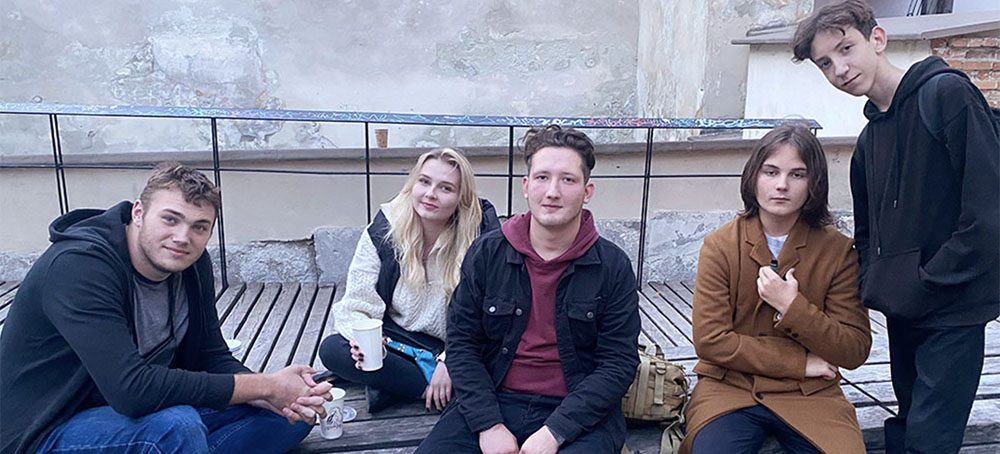 Young people hanging out at the Golden Rose Synagogue memorial in Lviv: Valter (cntr), a 23 year-old soldier on leave from the front, and (lft-rt) Oras, Adriana-Maria and the 14-year-olds Ruslan and Nazar. (photo: D. Blair/SRN)
Young people hanging out at the Golden Rose Synagogue memorial in Lviv: Valter (cntr), a 23 year-old soldier on leave from the front, and (lft-rt) Oras, Adriana-Maria and the 14-year-olds Ruslan and Nazar. (photo: D. Blair/SRN)
This is where it all began, both the massive, months-long protests in 2013, which stopped the kleptocratic, Russophile president, Viktor Yanukovych, and started what can be called Ukraine’s renaissance, and the escalatory overreaction. After the killing of over 100 protestors didn’t stop the movement, Russia's President Vladimir Putin ordered the invasion of Crimea and Ukraine’s eastern provinces and, eight years later, the entire country, which is now Europe's worst war since World War Two. Putin had to attack the democracy developing on his doorstep simply because, if Ukrainians and Russians are so alike and integrated, as he keeps saying, Russians will want democracy, too.
Ukraine isn’t releasing casualty figures for security reasons, and the Russian Federation’s are unreliable, but total deaths have probably passed 400,000, according to recent estimates, notably by the renown historian, Yale professor and Ukraine expert and language speaker, Timothy Snyder. Ukraine may have suffered as many as 200,000 casualties, around half civilian, some of whom were also victims of torture. Almost a third of all Ukrainians have taken refuge, some four million abroad and eight million internally, with up to four million deported involuntarily into Russia. On October 10th, Russia began a strategic bombing campaign against infrastructure, which will kill many more civilians during the winter.
As it happens, the Russian tanks barreling down Ukraine’s highway M-07 toward Kyiv on February 24th, 2022, were also trying to get to the Maidan.
It is bigger than I expect, over two football pitches, with 19th century buildings on one side and modern ones on the other. This being Sunday—September 11th, oddly enough—and with the sky still full of dark clouds, the Maidan is empty save a smattering of soldiers on leave, tight-skirted women sipping Ukraine’s ubiquitous strong coffee, and vendors of patriotic, yellow-blue wrist bands with sad eyes. There are no soldiers on guard, as far as I can see, but scattered around like overgrown toy jacks are tank barriers, the so-called “hedgehogs,” or “yizhaky” in Ukrainian, some painted like child toys, others stacked like modern art. They are the only indicator of the war raging 250 miles to the east or south.
“There were many business people on Maidan,” I was told by Kirill, a handsome, bearded and genial 34-year-old, who directs and edits television commercials and is writing a romantic comedy—he loves old Woody Allen movies. I met Kirill a week earlier in Lviv, the quaint, cobblestoned café city in Ukraine’s west which serves as its San Francisco and is somewhat shielded from the war in the east. I’m omitting last names in the nightmarish event of a Russian takeover.
Kirill invited me to his place with a cordial “I have wine, beer and cannabis” and recounted his many days and couple of nights on the Maidan in 2014, to which he commuted from the south-eastern city of Dnipro, now under Russian bombardment. “I saw head of Ukraine’s Microsoft on Maidan. There were many older people,” he said.
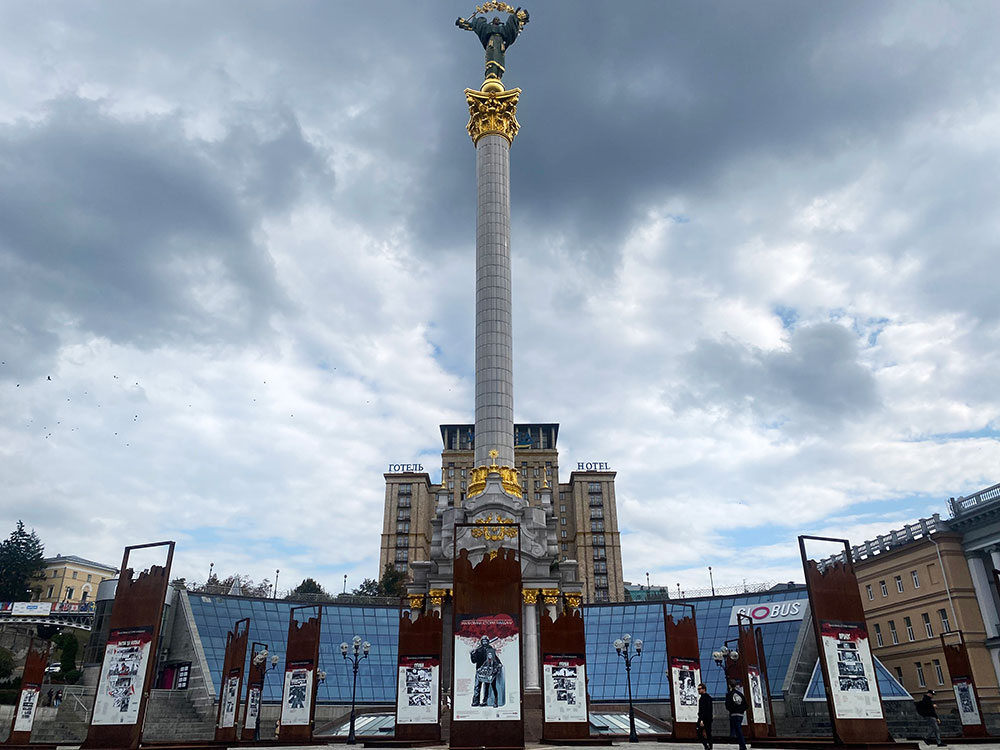
Ukrainian doesn’t have articles of grammar, so Ukrainians often omit them in English, including the “the” in their country’s former name, The Ukraine. “I still translate from Russian to Ukrainian to English,” admitted Kirill, who was raised speaking Russian, as were a third of his compatriots, including President Volodymyr Zelensky, part of Ukraine’s long tradition of being bilingual, trilingual or quadrilingual. Middle class Ukrainians often speak some or decent English, which they start studying in high school and continue while listening to rock. Kirill is a fan of Creedence Clearwater Revival, to which he was introduced by his father on cassette tape.
“There were even babushkas,” grandmothers in Ukrainian and Russian but also Yiddish, added Alena, Kirill’s girlfriend, who is in her early 20s, paints and is studying web design but could side hustle modeling. There were also priests, doctors, lawyers, teachers and entrepreneurs, although the vast majority were young people, not as many women as men, workers and students (including high schoolers), nationalists and anarchists, skinheads and hipsters.
Ukraine has a large cohort of tattooed-pierced, who wear their story on their skin: men with significant neck or face work, often referencing girlfriends, women with colorful “sleeve” murals and multiple piercings. A 40-something cashier at a small supermarket near where I lived for six weeks in Lviv, who had a ready smile when ringing me up, had a Chinese character on her neck.
“It was like a big family,” I was told by Artur, 22, whom I met on the Maidan six days later. Artur is a graphic designer, skater and fan of all things Californian, including the spiky hairstyle he sports. After two weeks battling baton-wielding police, the Maidan protestors settled into a few months of occupation, punctuated by marches, rallies and more police attacks. “There were big pots of tea cooking everywhere, people playing football, playing music, discussing politics, which I did not understand,” Artur explained, “I was only 14.”
“Then fighting started again. Yanukovych started shooting people. That really shocked us. We weren’t used to Ukrainians killing Ukrainians. That building was set on fire,” he said, pointing at a government office which protestors occupied and turned into a community center. “They restored it last year. Then Russia invaded Crimea.”
“Before Maidan, there was no Ukraine. After Maidan, there is a real Ukraine,” Artur concluded. “Most Ukrainians had friends on Maidan. Everyone knew we were no longer part of Russia, and we were a real country, a real democracy.”
It was called the Maidan Revolution or Euro-Maidan Revolution, because protestors gathered on the Maidan on November 21st, 2013, the very day Yanukovych cancelled Ukraine’s Association Agreement with the European Union in order to pivot to Russia, and they flew E.U. flags. The call to protest on the Maidan was first made by an Afghan-Ukrainian journalist, Mustafa Masi Nayyem, in a heartfelt Facebook post, which he closed with “Likes do not count.” After the killings, it became known as the Revolution of Dignity or simply the Revolution.
I saw photos of the martyred Maidanites on the fence of the National Art Museum. Called the “Heavenly Hundred,” they were a near even mix of youth and middle aged, working class and intellectual, albeit over 95% men.
Ukraine already had three democracy movements or revolutions, as they like to call them. The Granite Revolution of 1991 helped get out the 90% vote to secede from the Soviet Union. The less successful Ukraine Without Kuchma tried to oust Leonid Kuchma, the corrupt ex-communist, but he remained president until 2005, when he declined to stand for a third term. The 2004 Orange Revolution started after Yanukovych or his cronies tried to poison his opponent and steal the election but were stopped by Ukraine’s supreme court as well as the protests.
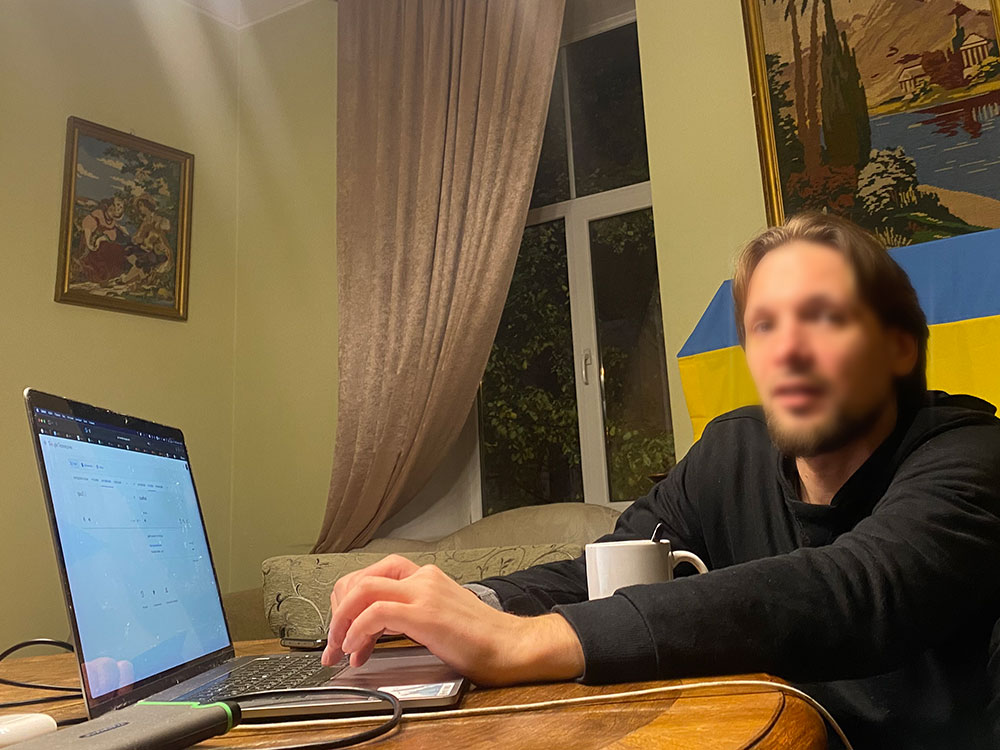
Kirill also participated in the Orange Revolution, when he was 16, which also involved fighting the police and camping on the Maidan in winter, but “It was not same,” he said.
Ukrainians continued to use mostly Russian in school, watch Russian television, and support Russophile candidates, including Yanukovych, whom they elected president in 2010, fair and square, even though he was a convicted criminal and notoriously corrupt—his son, a dentist, was one of the country's richest men. But Ukrainian politicians were often mired in corruption scandals; Ukrainians are understanding; and Yanukovych reinvented himself by hiring a hot-shot political consultant for a decade. That would be Paul Manafort, eventually Donald Trump’s campaign manager, a Russia security risk and a convicted fraudster.
“We have victim mentality from so much suffering,” Kirill told me, referring to Ukraine’s annihilation by the Germans during World War Two, when six and a half million people died, about a fifth of the population, but also by the Soviets. Nine million Ukrainians and perhaps many more died during the Russian Civil War (1917-22), the Great Terror (1936-38), and the Holodomor, when Soviet authorities starved to death about four million people to punish supposed counter-revolutionaries. Denied to this day by some Russians and Russophiles, the forced famine of 1932 to ’33 had two more iterations, in 1945 and ‘47, I was surprised to learn from a young intellectual I met working in a Lviv coffeeshop, Andrii.
“After Maidan, all that changes,” Kirill said, his voice rising slightly. “We understand we can change our life, and our life is in our hands. It is not what some people do to us—we can do what we want!” No wonder Putin was petrified.
As I pondered their incredible achievement on the Maidan, I recalled that many Ukrainians revere Stepan Bandera, a 1940s-era independence fighter and the leader of the more violent wing of the Organization of Ukrainian Nationalists, who is controversial but widely considered Ukraine's political founding father.
“Bandera? We love him,” replied Kirill, the first Ukrainian with whom I felt comfortable enough to ask about him, which precipitated an argument. As the son of a Polish-Jewish Holocaust survivor, I was painfully aware that some O.U.N. members had mass murdered Jews, Poles and Russians, the kernel of truth in Putin’s “Ukraine is controlled by Nazis” conspiracy theory. In fact, O.U.N. members brazenly slaughtered a few thousand Jews right on the streets of Lviv, some not far from where Kirill and I were sitting, the day the German Army entered the city, June 30th, 1941.
Kirill and I parted even closer friends, however, able to discuss difficult subjects. The genocideers numbered around 12,000, I later learned, from one of Professor Snyder’s Yale lectures uploaded to YouTube, while almost seven million Ukrainians were in the Red Army fighting the Nazis, a ratio of almost 600 to one. Two and half million of them died.
Contradicting another Russian conspiracy theory—that "Ukraine is not a real country and never existed”—they've been fighting for independence since the end of World War One, over a century ago, when they declared a state. Unfortunately, World War One morphed into the Russian Civil War, which swamped Ukraine in a ferocious free-for-all between the nationalists, czarists, anarchists, peasants and three foreign armies as well as the communists, who had to invade three times and use extreme violence to prevail (for this author's survey of that history go here).
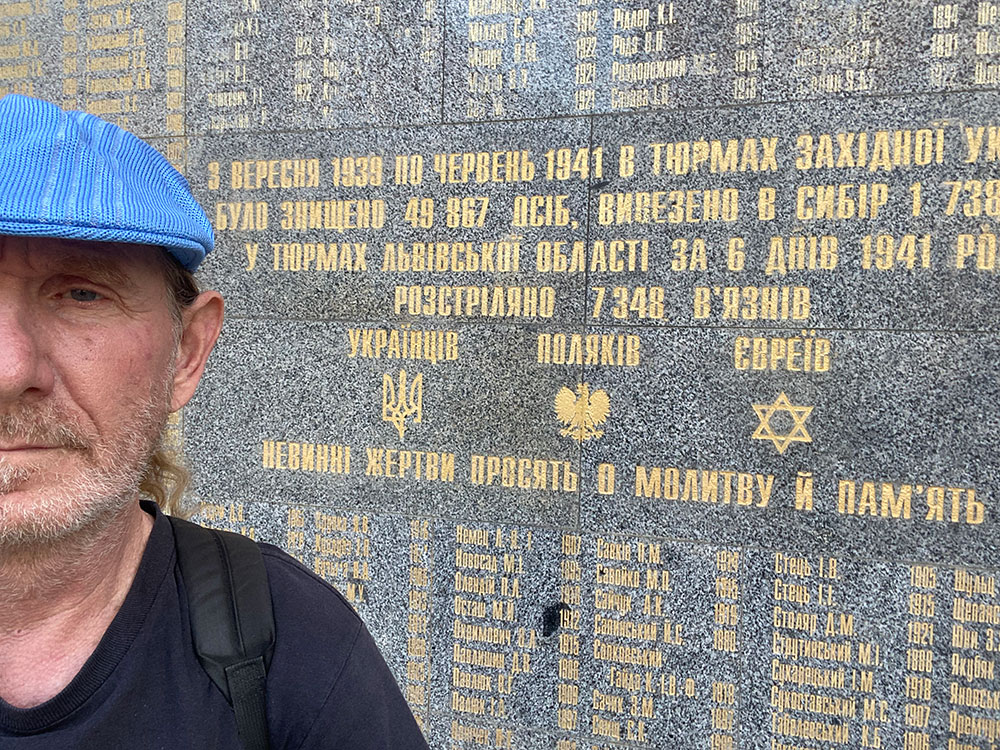
Given that sanguineous, two-part slaughter and then the Holodomor, the Great Terror and World War Two, 1914 to ‘45 in Ukraine was the bloodiest period in one of the bloodiest regions in history. In a desperate bid to carve out a country, the O.U.N. planned to expel the Soviets by siding with the Nazis, on whom they would eventually turn, while some members murdered Jews, Poles and Russians, in keeping with the eliminationist nationalism then popular across Europe.
As the war's outcome became obvious, however, much of the O.U.N. had a change of heart. Driven by a rank and file devastated by fascism, totalitarianism and the resulting wars, the leadership whitewashed that history and liberalized their platform, while their guerrillas kept fighting the Soviets into the 1950s. After the Soviet Union ended in 1991, the O.U.N. reemerged, supported right-wing parties, and remained central to Ukrainian culture, including through songs, street names and posters celebrating Bandera. Indeed, their greeting, “Slava Ukraini, heroyam slava,” glory to Ukraine, glory to the heroes, is still popular, and the army made it their official salutation in 2018.
Nevertheless, after the fall of the wall, when hard-right parties became popular across Eastern Europe, not much in Ukraine. In fact, only the Svoboda party passed the required five percent vote, and only in 2012, to take seats in the Rada, or parliament, a half mile from the Maidan. Although Svoboda has a Nazi-like insignia and started as an extreme ultranationalist party, it moderated some of its positions by then and won 38 seats, eight percent of the Rada.
“There were not that many on Maidan who were extremists,” Artur told me. “And they were not that extreme, like extremists in U.S. or Germany. I know one.” Ukrainians often have friends across ideological divides, which can be fungible, I learned, and some O.U.N. officials were friends with, married to, or themselves Jews.
There were a few neo-Nazi skinheads on the Maidan, mostly part of the punk movement popular across the ex-Soviet bloc for its ability to express anger. The founders of Right Sector, a hard-right party, met on the Maidan, where they helped lead its defense against the police. Republican Senator John McCain and Victoria Nuland, the U.S. Assistant Secretary of State for European and Eurasian Affairs, visited the Maidan and met with Svoboda and Right Sector leaders—Nuland famously handing out cookies. Although Nuland was supposedly managing American manipulation of the Maidan, the scandal surrounding her leaked phone call was mostly about her saying, “Fuck the E.U.,” and wanting to work around the institution so beloved on the Maidan.
Despite the Maidan’s diverse and vocal right-wing, however, they were vastly outnumbered and overshadowed by its liberals, leftists and anarchists, which is a powerful faction in Ukraine, one of the few countries where anarchists have mounted major parties or armies. Indeed, Svoboda lost all of its seats in the fall 2014 elections, despite its high-profile participation on the Maidan.
“There were a lot of poets on Maidan,” interjected Roman, Artur’s friend and fellow skater, who hadn’t said much until then. There were also many hippies, replete with long hair and colorful clothing, a movement dating to the late-‘60s in Ukraine, especially in Lviv.
During the Soviet dark ages, Lviv’s hippies lived underground, sometimes literally. They hid out in Lichakiv, the enormous cemetery for World War One soldiers but also politicians, authors and artists, who were often honored with large tombs and sculptures. I toured Lichakiv with Yarema, a photographer and artist with a gentle manner and shoulder-length hair, who wanted his photo taken next to the tomb of the sculptor Mykhailo Dzyndra, with its impressive abstract piece. Lviv’s most famous son is arguably Leopold Sacher-Masoch (1836-1895), a respected writer on Ukrainian and Jewish life as well as romance and eroticism (his name was borrowed for “masochism,” oddly enough, considering the longsuffering Ukrainians), but he is buried in Germany.
Yarema and I dined at the nearby Jerusalem, one of two Jewish restaurants in Lviv, which was almost a third Jewish until 1942, on a tasty mushroom-barley soup and gefilte fish, served by an interesting woman of color. I thought she might be Roma, given Jews and Roma sometimes ally on the edge of European societies, but Yarema learned her mother is Ukrainian and father Nigerian.
Yarema appears younger than his 31 years but has had gallery shows, teaches life drawing, does web development and carpentry, and recently produced a “jam festival” with friends, cooking kettles of fruit over a bonfire at his family’s run-down property outside Lviv, which he’s fixing into a small artists’ retreat.
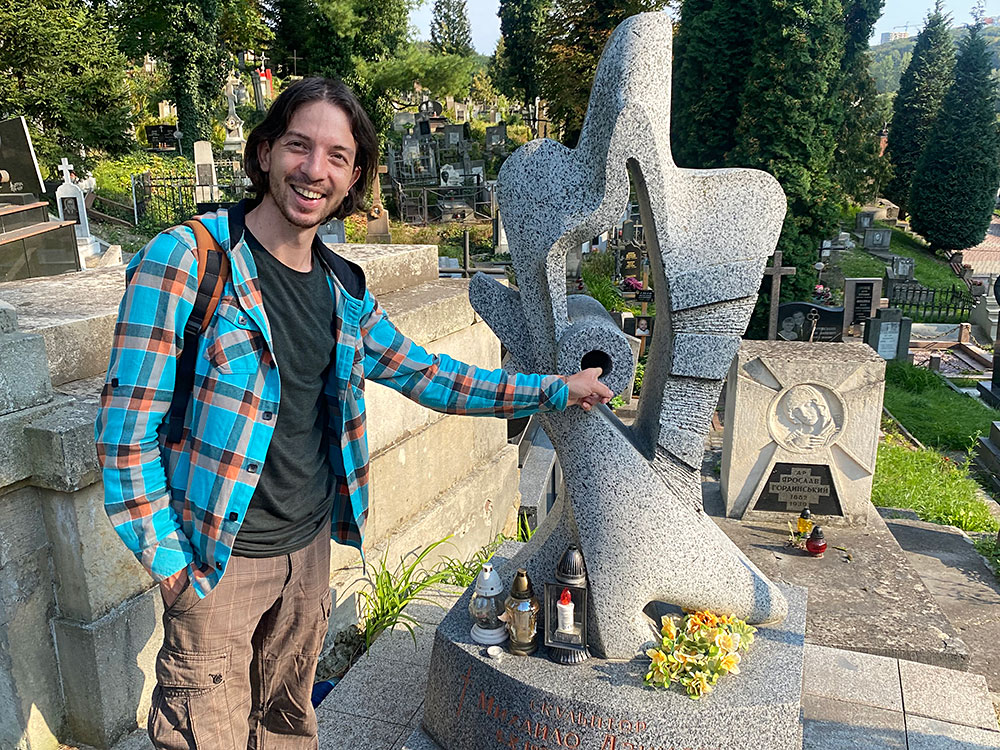
Lviv’s hippie history was also recounted to me by Bhodan, a 24-year-old artist and illustrator, who has read Jack Kerouac and Carlos Castaneda but also Amnesia.in.ua, a Ukrainian website run by “enthusiastic ethnologists,” and discussed it with his elders, like the director of Lviv’s Artists Guild.
During the ‘70s and ‘80s, people involved in "samizdat," the Soviet bloc’s clandestine free-expression movement, used tapes to share music, and they held small, illegal performances. Lviv had its first music festival after glasnost in 1989, Chervona Ruta, named for a popular love song and meaning a species of flowers or perhaps "red regret." It featured punk, pop and communist-era acts and became biennial, while the city became known for festivals. A well-respected jazz festival, originally called Alfa, now Leopolis, has been mounted every June since 2011, although this year’s was postponed “until immediately after victory,” according to its website. There are some great local jazz players, notably pianist Igor Yusupov.
The hippies took over Virmenka Street, in Lviv’s closed-to-cars Old Town, where they still preside in cafes like the homey Facet, which fills the street with tables in summer, or the massive, multi-roomed Dzyga, built into the city’s mediaeval walls and now one of its premier jazz venues and art galleries as well as cafes. Yarema had a show there of photos from his Turkey road trip. Hippies also started going to the Carpathian Mountains, 250 miles south of Lviv, especially a waterfall called Shypit, meaning to whisper, “to camp out, play music and run around naked,” according to Bhodan, who hitchhiked there with his girlfriend a few years ago, for the summer solstice celebration.
“Up to one thousand people… gather and make a big fire and celebrate life, or whatever, using psychedelics, marijuana and music… There are little customs. No matter of the time, if you meet someone, they tell you ‘Good morning.’ Some people wake up in the evening because they were partying all night… You can join any small conversation with people you never met before—you can have heartwarming discussions.”
Considering the Maidan protesters' dedication to freedom and their months of street fighting, which culminated with police snipers shooting about 100 of their comrades, Yanukovych fleeing to Russia, and the Roda voting unanimously for fresh elections, they were enraged when Russia attacked Crimea on February 20th, 2014. Insignia-less and masked soldiers poured out of the Russian naval base in Sevastopol, which dates to 1772 and was being rented from Ukraine. Evidently, two pro-democracy revolutions in one decade was too much for a Kremlin turning autocratic under Putin. Crimea’s governor chose not to fight, since the state had become almost entirely Russian-speaking after the Muslim Tatars were deported to Siberia in 1944, and it had substantial autonomy from Kyiv.
Sanctions were levied and the ruble collapsed, but President Barack Obama, Chancellor Angela Merkel of Germany and other western leaders accepted the conquest of Crimea as a real politic fait accompli. Citing its Russian-speaking population and Russia's lingering superpower status, they rationalized it was not worth significant protest or an escalatory arming of Ukraine, especially so soon after the disastrous Iraq War, and that stable relations would encourage Russian democracy.
Across Ukraine, there were also Ukrainian speakers, generally older and male, who opposed the Maidan and its related protests nationwide and supported Russophile politics. Some Russian speakers claimed discrimination by a Ukraino-centric establishment, but it's hard to distinguish valid complaints from opportunism or corruption by Russian patronage and conspiracy theories. In the eastern states of Donetsk and Luhansk, Russian language speakers and some paid agents started separatist rebellions in April 2014, using small squads of ragtag fighters. But they soon obtained weapons from the Russian army, which quietly invaded four months later, even as Putin categorically denied to Obama’s face any involvement with the “little green men.”
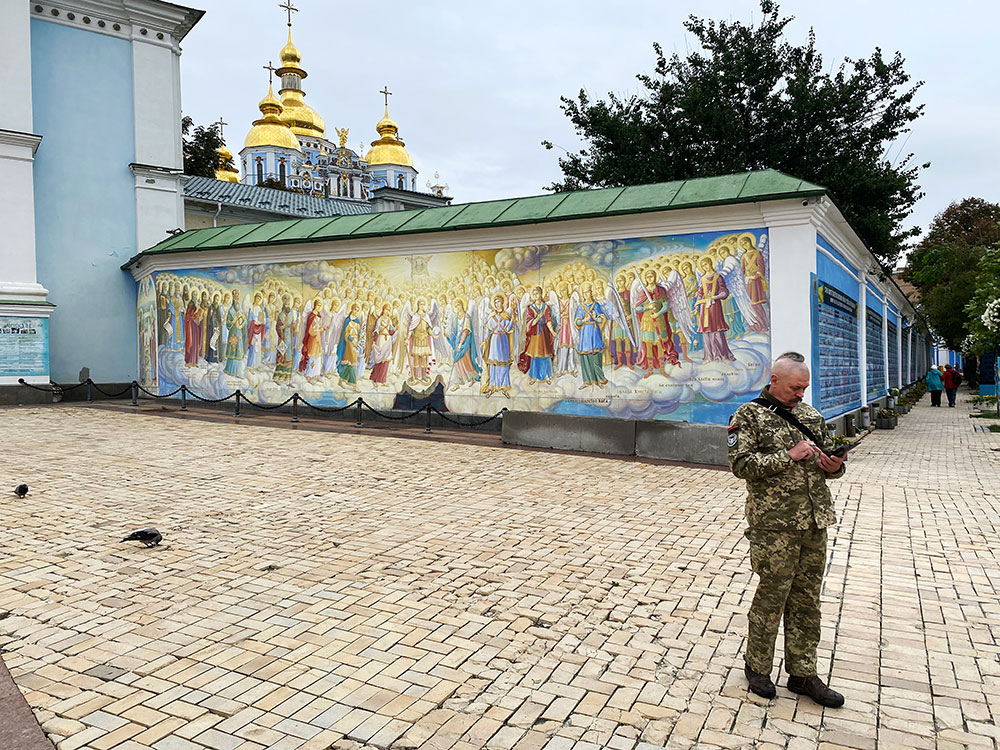
Militant Maidanites ran to the army or the paramilitary outfits organized on the Maidan by older veterans of the Soviet-Afghan War or younger Russian speakers, which belies allegations of widespread oppression. The latter were often soccer hooligans, also called “ultras,” or, to a lesser degree, white nationalists or punk intellectuals. The first commander of the now notorious-famous Azov Battalion, Andriy Biletsky, had a degree in history and decade experience organizing those three groups. The Azov debuted as a lightly-armed militia to oppose the separatists threatening Kharkiv, Ukraine’s second city and next to Russia, but came of age in the large city of Mariupol on the Azov Sea, off the Black Sea, hence their name. After Ukrainian Army units in Mariupol proved poorly equipped and commanded, Biletsky led his fighters south and defeated separatists in open battle, in the summer of 2014.
More pacifist Maidanites often supported their friends and relatives who were fighting with supplies, equipment, medical or cyber services, or money. A journalist, Miriam Dragina, started a flea market, Kyiv Market, specifically to donate its profits to the army, which recalls the old joke: What if the library got funding and the army had to do a bake sale? Some simply bought sport rifles and drove to the front. The Azov and other independent brigades were integrated into army command by the end of 2014, but the war is still a very popular, anti-imperialist insurgency, much like the American Revolutionary War or Vietnam-America War, involving people from all walks of life and political persuasions. Almost everyone I met was helping supply a unit with food, automobiles, ammunition and more.
Another testament to Ukrainian democracy is the 2019 election of President Volodymyr Zelensky, who is Jewish—as were two of Ukraine’s six other presidents—in a landslide 73% of the vote, due to his anti-corruption stance but also charmed life-follows-art story. Four years earlier, the accomplished comic, actor, writer, dancer and producer had created and starred in a hit television series, a combination sit-com and political satire with surrealist touches, “Servant of the People” (2015-19, available on Netflix). Zelensky plays a bumbling high school history teacher, living at home with his taxi-driving father and professor mother, whose students film him ranting against corruption. After it goes viral, they file the papers for his presidential run, which everyone regards as a joke until—spoiler alert—he wins and takes on the establishment with the help of family and friends.
Also appointing friends as ministers, the real-life President Zelensky, whose political party is called Servant of the People, had a shaky start. Despite successes countering corruption, he was accused of nepotism and favoring the oligarchs backing his large media company, and he made egregious accusations against his predecessor, which earned him low approval ratings. Doing his fictional character one better, however, Zelensky matured into a charismatic commander who refused to flee, rallied his constituents amid catastrophe, staved off defeat, and assumed a starring role in the ancient contest between democracy and fascism.
Also determined to stop Russian expansion are the 20,000 or so foreign fighters, notably the Georgians, whose nearby nation Putin invaded in 2008, due to their Rose Revolution five years earlier, and who have their own brigade, and the much more brutalized Chechens. Indeed, the Chechens endured not one but two vicious wars with Russia (1994-96 and 2000-01), which killed over 100,000 people, fully seven percent of their population. There are also fighters from America, Scandinavia, Britain and other regions, including an increasing number of Russians.
A small cadre of foreign volunteers covers the gaps in citizen care left by governmental and international agencies and Ukrainian self-help networks, often focusing on communities with emergency needs, helping disabled refugees and delivering lost pets, which can be considered therapy animals. Dirk and I met eight of them for beers at an upscale pizzeria, in the park next to Kyiv’s urban velodrome, a lighthearted but dedicated crew of Australians, Canadians, Europeans and one American.
Another democratic indicator is that the ultranationalists haven’t held a Rada seat since 2019, when Biletsky lost his, and Zhan Beleniuk became its first African-Ukrainian representative. A wrestler who took gold at the 2020 Summer Olympics, Beleniuk was number ten on the list for the Servant of the People party, which won 125 seats. The Azov, meanwhile, received funding from a Jewish oligarch, sacked a commander for antisemitic speech, and accepted Jewish fighters. Most importantly, they’re fighting to defend Ukraine against an imperialist invader committing genocide.
Genocide, as defined by the United Nations, is the attempt to eliminate a culture, language or nation as well as people. Russian intentions are clear, from their officials' overt references—“Ukraine is not a country”—to military actions: the bombing of civilian infrastructure and cultural institutions, the destruction of monuments, including to the Holodomor, the use of rape as a weapon of war, the deportation of children and young women into Russia to be Russified and estranged from their families, and the sadistic torture of civilians, using amputation and castration.
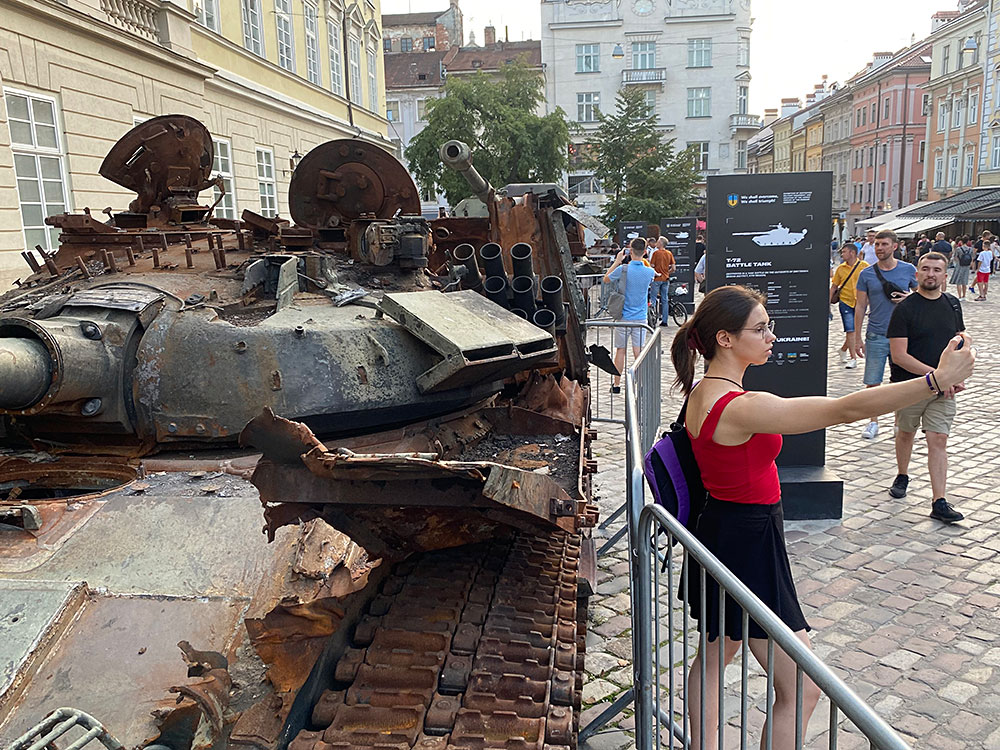
No wonder the Azov enjoy nationwide adulation, notably the big banners honoring the “Azovstal Defenders” in downtown Kyiv, Lviv and other cities, for their second defense of Mariupol, from March 1st to May 20th, 2022, when they fought the Russians to the death.
“They are like gods!” I was told by Oksana, an effervescent woman of about 22, whom I met in Lviv, after offering to take her selfie in front of the city’s display of destroyed Russian tanks. Oksana studied computer programming but much prefers working as a recruiter for the Georgian Brigade.
The Stalingrad-like siege of Mariupol destroyed or damaged over 90% of the city’s structures and may have killed up to 85,000 civilians, according to recent reports, including almost 600 sheltering in a theater marked “children” in large letters on March 24th. About 3,000 fighters, some foreign, and 1,000 civilians, including children, retreated to the massive, Cold-War-era bomb shelters beneath the city-sized Azovstal Iron and Steel Works, which is owned by a Muslim-Ukrainian oligarch. As gangrene, black mold and starvation set in, under constant bombardment, including by thermobaric bombs, with only a few helicopters flying supplies in and wounded out, 20 feet above the water to evade Russian radar, the mostly Azov fighters endured for 11 weeks.
Mariupol’s Thermopylae cum “Blade Runner” cum reality TV show was watched by many Ukrainians on videos uploaded thru the Starlink satellite system, which was largely donated by Elon Musk and is also essential for operating drones and artillery. The siege ended when the surviving defenders received safe passage in exchange for a few high-profile Russian prisoners, although 53 Azov were murdered in a Donetsk P.O.W. camp on July 28th. They were killed by Ukrainian shelling, according to Russian officials.
“How did you grow up so healthy in such an environment?” I asked Kirill, the next time we hung out. “Was your father an optimist?” “Yes,” he said. “He was a good man, nice man. He liked rock music and was devout Christian. And he was Jewish.” Kirill only learned that fact after his father died and, just last year, that his mother is as well, a secret they kept iron clad due to Soviet and Ukrainian antisemitism.
Nevertheless, the secret Jewish parent or grandparent story is fairly common in Ukraine. I met many Ukrainians with Jewish heritage, and Kirill once joked, “Half of Lviv is half Jewish.” And Jews date to the eighth century, when the elites of the Khazar Empire converted to Judaism, over a century before the birth of either Ukrainian or Russian culture. Despite the many gruesome pogroms—by the Cossacks in the 17th century, which included extensive rape, the czarists in 1920, and the Nazi genocide of one and a half million Ukrainian Jews—and today’s small number of publicly professing Jews, about half a percent, they remained somewhat integrated and represented throughout the country. Indeed, Ukraine still has Europe’s second largest Jewish population: coming after Poland before World War Two, now following France.
President Zelensky, 45, hails from a modest city in central Ukraine and studied law before going into entertainment. Natan Khazin, a 50-ish rabbi from Odessa, Ukraine’s third largest city and historically Jewish, was on the Maidan and helped its fighters with his experience in the Israel Defense Forces. Khazin even calls himself a “Zhido-Bandera,” a Jewish follower of Stepan Bandera. Nayyem, the Maidan organizer of Afghan extraction, married a Jewish woman and is raising his children Jewish. Meanwhile, the annual number of antisemitic incidents in Ukraine is often less than in France or England.
Kirill adores his mother, as becomes obvious when he takes her calls with a dulcet “Yes, Mama?” In fact, he moved her to Lviv, and her own apartment, when he and Alena evacuated Kyiv in December 2021, two months before the war. “I was listening to BBC and your president,” he explained. Kirill thinks Zelensky may have to answer for why Ukraine was so unprepared for the invasion: “They were building roads, when they should have been building rockets.” “But only after the war,” he added.
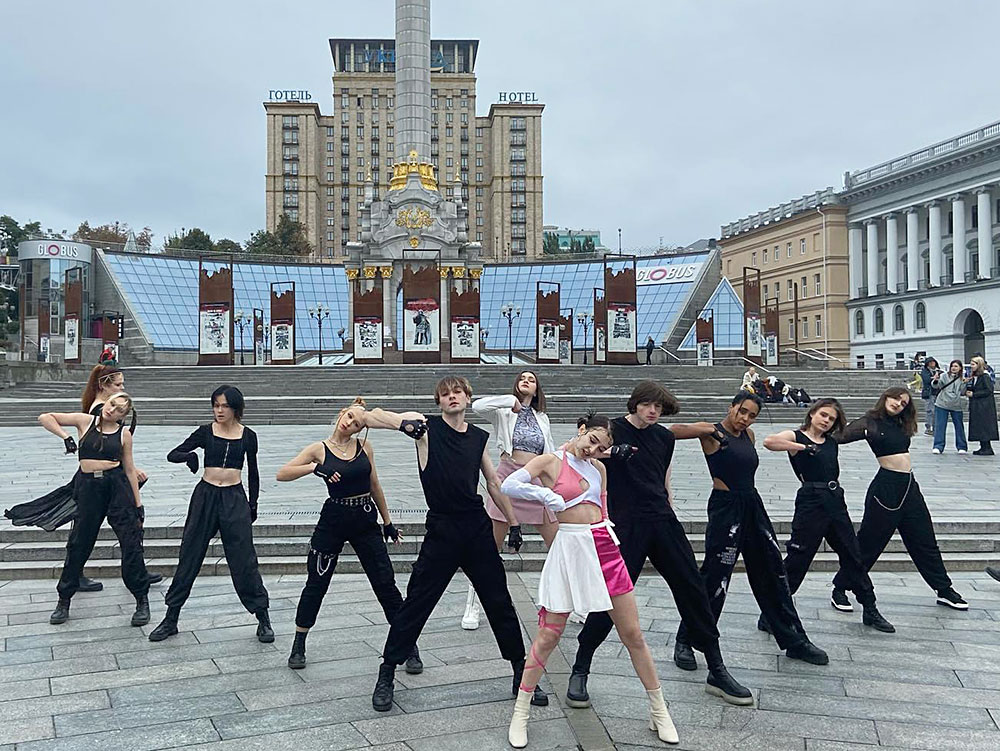
Ukrainian women seem extra loving, as is often the case in oppressed communities. I noticed on the streets of Lviv and Kyiv how they cared for children, who often clutch stuffed animals, due to the anxiety of war, or walk with beaus, holding hands and laughing, or girlfriends, in pairs or groups, also holding hands and laughing or chatting animatedly while out for coffee. Or when they cry and hug. Many seem to be Eastern European romantics, cautiously hopeful in the face of adversity, a worldview I learned about from my Polish mother and on four trips to Poland, Ukraine’s sibling society (Lviv was Polish until the Soviet invasion of 1939).
Their literary romanticism, meanwhile, dates to the poet, painter and folklorist Taras Shevchenko (1814-1861), who was born an enslaved serf near Kyiv but secretly read books and studied art and became the country’s cultural founding father, honored many times more than Bandera with street names, statues or on the currency, the hryvnia (pronounced “ravinia”). Other luminary local authors include Nikolai Gogol (1809-1852), who became a titan of Russian literature by inventing “the grotesque," an essential genre for understanding Eastern Europe, Sholem Aleichem (1859-1916), whose tales of Jewish life inspired “Fiddler on the Roof” and Mark Twain, and Isaac Babel (1894-1940), also from Odessa and also Jewish, one of the Soviet Union’s most respected authors and journalists as well as modern stylists, until the secret police murdered him, in keeping with their grotesque tradition of killing people to solve problems.
As Dirk and I walk out on the Maidan that glorious September 11th morning, I am struck by its large, open space but also strange structures, like the glass domes or comedic sculptures at its north end, where we entered, or the tall column capped by a figure in the distance. Despite the storm clouds, a wan sun shines, people are smiling, and there’s an eerie peace.
Unbeknownst to us on the Maidan at that moment, 250 miles to the east, around Ukraine’s second city of Kharkiv, Ukrainian Davids are on the march. Indeed, they retook more territory in days than the Russian Goliath conquered in months, driving the invaders into a panicked retreat and to abandon immense amounts of equipment and ammunition. President Zelensky announces this battlefield success that very evening, in his nightly national address, the first good news Ukrainians have heard since their storied defense of Kyiv, six months earlier.
“They used special forces, drones and ‘maneuverable warfare’ to get behind the Russians and spook them into running,” a military analyst on CNN explained on September 13th, although he forgot to mention their masterful military feint. For weeks, President Zelensky had been talking up a counterattack in the south on Kherson, the only regional capitol conquered in Russia’s most recent invasion, which tricked them into withdrawing troops from the north near Kharkiv. Already known as a brave and funny commander in chief, Zelensky was proving to be a brilliant one.
“We love our president,” Alena had told me with a smile, which suggested a romantic-sexual side to national struggle.
Zelensky pushed his generals to attack, even though the Americans kept vetoing their battle plans, as the two militaries computer war-gamed during the summer in Ramstein, Germany. They had to break the entrenched front lines before winter, obviously, as a frozen war of attrition would benefit better-armed Russians. But they also had to prove to citizens and allies alike that the cornucopia of donated war materiel was being put to good use. As of September 11th, the U.S. had provided about $19 billion worth, five times the annual allotment to Israel, including advanced HIMAR missiles and promises of much more, although that could be reduced or decimated by a Republican-controlled Congress.
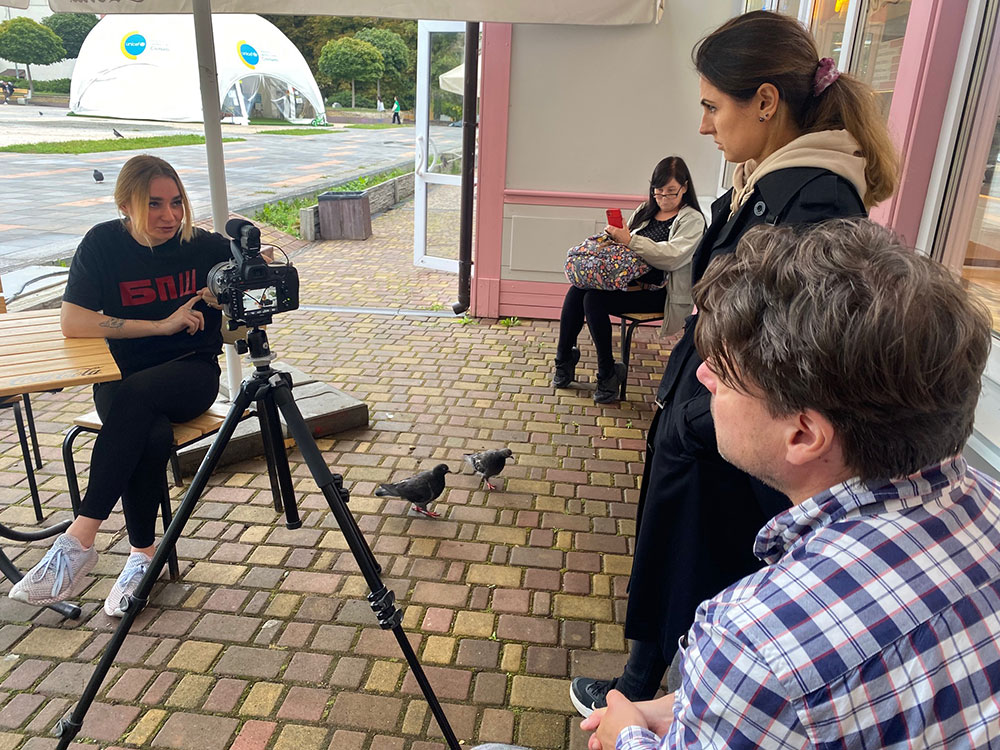
Dirk and I thread our way across the six lanes of Khreshchatyk Avenue, Kyiv’s main shopping street, which intersects the Maidan, since we neglected to notice the pedestrian tunnel for that purpose. We ascend the Maidan’s block-wide steps and approach its centerpiece, the gold-plated column crowned by Berehynia, the Slavic fertility goddess. Only then do we see, in the middle of the square’s proscenium, the dance troupe. It consists of a dozen women, including one of color (Ukraine has a substantial Roma population as well as some African immigrants), two men and a camera crew. Between takes of turning, jumping and gesticulating, the dancers goof off and giggle, although still well aware of the fierce battles raging five hours drive east or south. Each one probably has a cousin or friend under shellfire, at the front or already in the earth.
Kyiv seems normal, except for the passport control on the roads entering town and at the train station, the sandbags and plywood around important buildings and statues, the machine gun nests at official entrances, and the occasional air raid sirens, which oblige museums to evacuate, but everyone else ignores. People laugh in the streets, and the restaurants are full—up to a 30-minute wait at the most popular—but few openly celebrated Zelensky’s announcement of battlefield success on September 11th, as was reported in the American press. Almost everyone I met was still nervous, some were traumatized, and a few were having panic attacks.
Fifteen miles north of the Maidan is Bucha, whose residents reported the first Russian war crimes spree. Bucha bore the brunt of Russian bloodlust because it was where their once-vaunted armor was ambushed by Ukrainian regulars but also townspeople tossing Molotov cocktails. The Ukrainians destroyed up to a dozen tanks and vehicles which triggered a 25-mile-long military traffic jam and ruined Putin’s plans for a one-week war. Amazingly, the Russian soldiers carried dress uniforms for a victory parade, while many officers booked reservations at Kyiv’s premier hotels and restaurants.
Dirk Grosser is of medium height, strong build and open demeanor. He favors plaid shirts and hiking boots, perhaps in deference to his practical people from the once-East German city of Dresden, where he lives in a three-story townhouse he renovated himself. On our deluge drive from Lviv to Kyiv, Dirk told me how he raced all night from Germany to Ukraine, after a late start due to house guests, to attend a seminar he organized about what artists should do during a war. A performance artist and filmmaker by profession, Dirk started doing small conferences in this vein after learning some of his leftist friends supported the Russian invasion. In addition, he was shooting a related documentary, tentatively titled “Exile”.
Amazed by Dirk’s ambition and hard work as well as interested in the cause, I volunteered to production assist: find translators, do second camera and the like. Three days after our first Maidan visit, we drove the M-07 north to the once-bucolic commuter town of Bucha. We set up next to its verdant central walkway in the outdoor tables of a fast-food joint, which had umbrellas to ward off the light rain.
Every person we asked had had harrowing experiences. “I was in a basement for weeks,” a towheaded, ten-year-old boy, riding around on his scooter, told us, “I was very scared.” After calling his mother on his smart phone, which almost all middleclass kids have, he said, “She doesn’t want me filmed.”
Between wiping her eyes, a thin, expressive, perhaps 50-year-old Roma woman named Nadia told us about the rapes, including of underage girls, the men trying to remove their military tattoos, a death sentence under Russian occupation, the summary executions, which sometimes included torture or amputation, and the often audible screaming. The interviews were conducted in Ukrainian, which neither Dirk nor I understand, but our translator, an aid organizer from Kyiv also named Nadia, provided periodic summaries in English. At the end of the interview, most of us were crying, and we all hugged Bucha Nadia.
Bucha’s streets were littered with bodies for weeks, since the residents were too fearful to collect them. The kill count now exceeds 450, almost 2% of the population but will probably go much higher. Mass graves full of civilians, some showing signs of torture, amputation and even castration, have been uncovered in the liberated towns around Kharkiv like Izium.

“We were given orders to kill everyone we see,” a Russian soldier told his girlfriend by phone from Bucha, according to call transcripts published by the New York Times on September 28th.
Evidently, the Kremlin intends to terrorize the Ukrainians into submission, including the ethnic Russians they're supposedly saving, and escape recrimination through propaganda and conspiracy theories. This strategy will work, they assume, by virtue of their long expertise with such subterfuges but also the current popularity of conspiracism worldwide and cyberspace's capacity for disinformation. Hence, the Russians keep claiming they're fighting Nazis, even as they become like Nazis. Despite the obvious hypocrisy, their repetition of big lies allows them to not only dodge the bad press but transfer it to their enemies.
As if on cue, when the Bucha story broke on April 1st, Russian diplomats and media figures began accusing the Ukrainians of lying and fabricating evidence, using actors, ketchup and Photoshop, a gaslighting calumny that many Russians and Russophiles continue to repeat ad nauseam today.
On our way back from filming in Bucha, to complete our atrocity tour, we stopped by Babyn Yar, the ravine four miles north of the Maidan better known by its Russian name, Babi Yar. This is where the Nazis, also compulsive conspiracy theorists, slaughtered some 33,700 Jews in two days, still considered a record. Now located in a large, popular city park, Babyn Yar features an imaginative, multifaceted memorial. Right on the ravine’s edge, in fact, is a two-sided synagogue adorned with colorful animals, clouds and Hebrew phrases, a fantasy version of a traditional Ukrainian synagogue. The walls are hinged and there is an oversized hand-crank, the guard showed me, which folds the entire structure into a 20-foot-tall wooden case, suggesting children’s theater or the Jewish need for portability.
Some people were probably offended when the Babyn Yar Memorial foundation—formed in 2017, after the Soviets downplayed the Holocaust for decades, with an all-star board chaired by the Russian-Israeli scientist and dissident Nathan Sharansky and featuring rabbis, artists and politicians—decided to build a psychedelic, fold-up synagogue to commemorate what is traditionally marked by dark stone memorials or anguished sculptures. I myself was confused. But as I walked around and mulled it over, I realized: This is where Ukrainian middle schoolers are brought to look down into that monstrous death hole and, if you want to get metaphorical about it, what the souls there see looking up. Surely a positive image of Ukraine’s millennia-old Judaism provides some solace.
Dirk and I hiked down the path behind the synagogue into the ravine, which must have been deep, given it now holds around 90,000 Jewish bodies, almost all of Kyiv’s pre-war Jewish population, and a similar total of Roma, Russian and Ukrainian nationalist bodies, an irony not lost on some Ukrainians. Dirk can be contrarian, but he readily joined me in a meditative “om” chant. As a Holocaust survivor’s son, who has long grappled with this apocalyptic nightmare, I felt a certain peace in Babyn Yar’s death hole: Ukrainians were finally healing from that national trauma using sophisticated art and psychology. Tragically, it was just in time for the next atrocity.
Babyn Yar’s memorial complex also has an eight-foot, dark stone menorah, which serves as its centerpiece, and a large, black stone wall, although unlike anything I’ve seen at other Holocaust memorials. Titled “Crystal Wall of Crying” and installed in 2021, it was designed by Marina Abramović, the legendary Serbian performance artist, and has dozens of large crystals, which glow with light and are embedded in the wall. A football pitch away, there is a large, circular, silver platform with a dozen silver pillars, each fitted with an eyepiece for viewing archival Holocaust footage—everything riddled with bullet holes. The Holocaust in Ukraine was largely by bullets. Neither “Psychedelic Synagogue” nor “Riddled Silver Pillars” are listed on the Memorial’s Wikipedia page, and I’ve yet to find their creators’ names or installation dates.
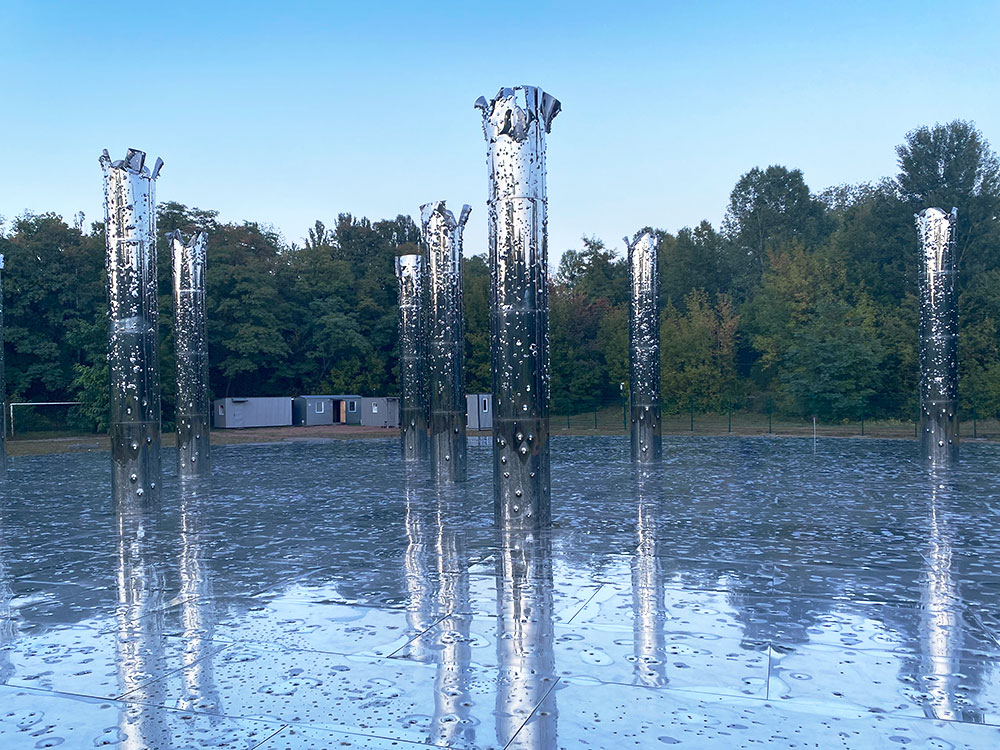
“When Bucha happened, we were all crying,” I was told by Marina, a 20-something woman who works in the arts, including promoting her reserved painter boyfriend, and has an irrepressible laugh. “But we can’t stay that way. If we let them depress us, they will win.” Many Ukrainians told me they were depressed for a week or a month after February 24th but were energized by friends, the exigencies of war or Ukraine’s stoic tradition.
Marina, whom I met in Lviv but is also a refugee from Dnipro, which is half way between Kharkiv and Kherson and was being shelled as we spoke, just returned from the U.S., where she visited her mother in Minneapolis and could have applied for refugee status. “I saw only a few Ukrainian flags or signs of solidarity,” she said. “At a club, the singer said she wanted to dedicate the next song to those who have suffered. I thought she meant us, but she was referring to George Floyd.” Marina also spends all her earnings to support Ukraine’s economy.
“Some people say this being happy is wrong,” Kirill told me. “But my friends who are soldiers say, ‘We have to protect this. You must do your normal life because we are in stress, and sometimes we need to go enjoy this.’” Kirill’s friends reminded me of the Babyn Yar installations, which I came to see as suggesting we appreciate life even as we mourn mass death, learn about horrific history and fight fascism, which I also learned from my mother's experiences in the Holocaust. The Ukrainians perfected this philosophy, evidently, over a century of being butchered mercilessly by the Soviets, Germans and now Russians.
“Some people outside the Maidan were angry with us, saying, ‘It was like a festival, not a protest,’” said the Ukrainian popstar Ruslana Lyzhychko in “Winter on Fire” (2015), an excellent documentary about the Maidan Revolution (available on Netflix). Ruslana, as she is known, was also a center-right Rada representative but fell in love with the kids of Maidan and became their celebrity spokesperson.
As the Maidan dancers prance and gambol across Ukraine’s main stage, with no official minders and only Dirk, myself and four or five others watching or filming, I realize I’m witnessing a minor miracle: Ukrainians expressing freedom, fancy and joy in the shadow of a gruesome, genocidal war. When they take a water break, however, I continue my exploration and wander up the steps to Berehynia, standing resplendent in the slight sun, gold leaf gleaming off her column and the foliage she holds above her head.
That’s when I notice, behind Berehynia’s column, the art show: two dozen, ten-foot-tall, artistic iron easels with pages from a graphic novel, "Dad" by Oleksandr Komiakhov, I find out by Google Translating a photo of the credit. The title page surprises me. It has a man and woman seemingly straight from the Burning Man festival: him heavily bearded, wearing a motorcycle helmet and holding a baseball bat; her with pierced lips and a furry cat hat and cradling a box of Molotov cocktails.
“If these are the mythical heroes of Ukraine,” I think, or something along those lines, “They really have achieved a certain free speech absolutism, and freedom in general, a democracy which enshrines art and ideas, which many Ukrainians have been enjoying for almost a decade… Many of the kids of Maidan must be in government by now.”

“They are all phonies, patsies and spies!” would the rebuttal of many Russophiles and hard rightwingers but also some leftists, including friends of mine. Sandy Sanders, a neighbor, artist and seemingly decent guy, whom I’ve known for 20 years, denounced one of my heartfelt Facebook posts from Ukraine by insisting the Maidan Revolution was a “U.S.-financed coup” and the separatist struggle in the Donbas was a “neo-Nazi civil war.” Since he doesn’t seem like a Machiavellian manipulator, Sandy must be utterly unaware that he’s parroting Putin’s conspiracy theories, that people power is organic and hard to manipulate, or that fascist societies can't be paragons of liberty.
In fact, there’s precious little police presence in Ukraine, although martial law was declared on day one and they’re in a duel to the death with an adversary thrice their size and with a long resume of atrocity and spy craft. Indeed, three teams of pro-Russia Chechens tried to kill President Zelensky early in the war, the attack on Kyiv's secondary airport by Russian paratroopers and over 100 helicopters delivered special forces to decapitate the government, and they continue attempting to infiltrate spies, saboteurs and assassins, or to enlist them in sitio.
Nevertheless, in all of downtown Lviv, I saw only two soldiers standing guard (the 24-hour sentries at the central bank), while the nationwide curfew of 11 p.m., widely adhered to by Ukrainians, was barely enforced. On my many walks home at midnight or later, I saw few police patrols and no stops.
Five days after my first Maidan visit, I was stopped by a soldier who saw me take a selfie near a trainyard and demanded my phone and passport. I braced myself. “There is still a lot of corruption,” a few Ukrainians had warned me. Fifteen minutes later, however, I was chatting amicably in English with his commanding officer, who asked me to delete the photo and dismissed me with “Have a fun visit to Kyiv.”
Also defending Ukraine from Russian espionage is their “safe city” system, using surveillance cameras and artificial intelligence, Kirill told me. Amazingly, at the start of the war, Ukrainian cyber security held off the onslaught of Russia’s notorious hacker army. Others referred to their long, painful learning curve with Kremlin agents. “The K.G.B. killed my grandfather,” a long-haired Lviv waiter told me with a laugh, “It’s a sad story.”
As I review the Maidan's graphic novel, I am struck by the quality of Komiakhov’s drawings and visual storytelling but also that I’ll need a translator to make sense of it, so I circle back to Berehynia. Sitting next to her majestic column, surveying her sacred domain, the quarter-mile oval of Maidan Nezalezhnosti, or Independence Square, the name it was given after the 1991 Granite Revolution, I think about what Kirill, Artur and the others said, or I have read or viewed. Bit by bit, I begin to imagine how the Maidan looked eight years ago: teaming with tens of thousands of demonstrators—up to a million on some marches—waving signs and E.U. flags and chanting, “Ukraine is part of Europe!” “Together to the end!” and, after the police attacks, “Convict out!” directly at Yanukovych.
They also carried plastic sheets for the torrential rains. Within a few weeks, that plastic was woven into a sea of tents, barricades, lean-tos and kitchens, inhabited by a vast cross-section of Ukrainians, from tech workers and academics to dirty, young men carrying bats. One young man told me his dad went to the Maidan because “he always had to be in middle of everything,” while another said his dad promised to take him, but his mother intervened—he was only 14. The protesters discussed and debated, played guitars and drums, and DJed and danced, even though there was almost no alcohol on the Maidan. When temperatures plummeted and snow blanketed the vast encampment, they gathered around 50-gallon-drum fires.
As I ponder this critical history, about which I knew little before entering Ukraine on August 23rd (its Independence Day from the Soviet Union, coincidentally), a moving moment from the Maidan Revolution—one I just learned about from the documentary “Fire in Winter”—comes to my mind.
After two weeks of protests, the Berkut riot police tried to clear the Maidan a second time. Their first attempt, on November 30th, 2013, merely shocked the protestors, who fought back fiercely or called their parents, some of whom joined them on the Maidan. The night of December 10th would be different, they realized, as they watched police buses pull up on Khreshchatyk Avenue and spit out hundreds of officers with helmets, shields and cement truncheons. As the women went to the proscenium for protection, some of the men—some wearing helmets, many carrying bats—went to face the Berkut. Meanwhile, a lone figure sprinted away, a theology student named Ivan Sydor.
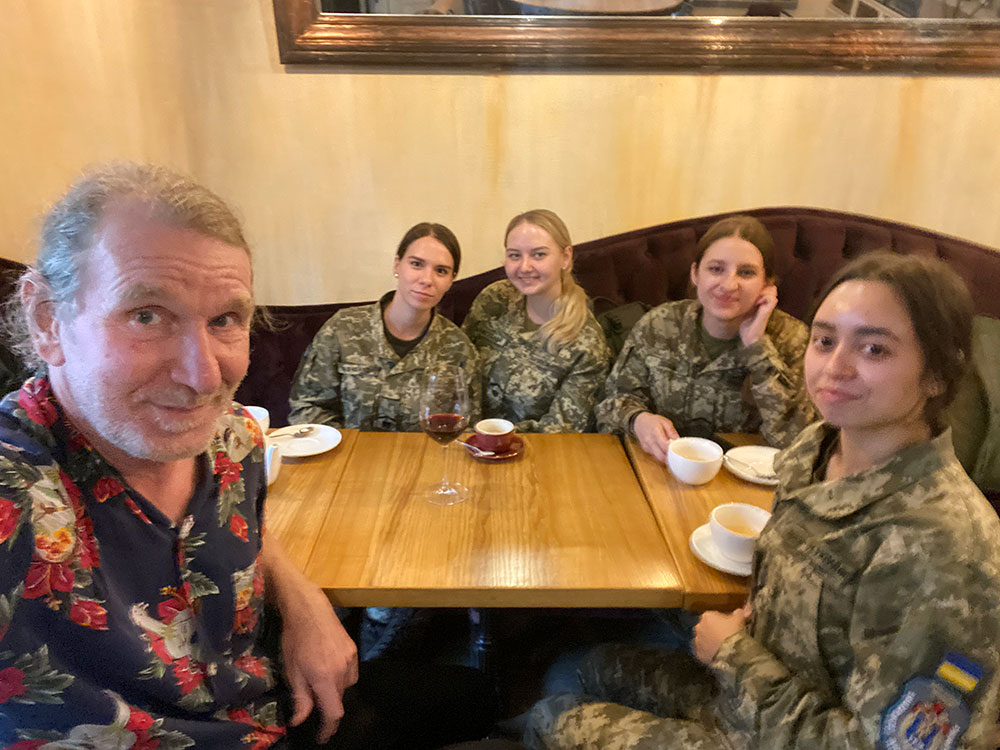
As it happened, the official bell ringer for the 11th century Cathedral of St. Michael, on the hill north of the Maidan, was Sydor. Undoubtedly gasping for breath as he topped the belfry stairs around 1 a.m., he began ringing St. Michael’s bells furiously, as had his forbears during the Mongol invasion. Sydor rang for four hours and roused thousands, who ran to the Maidan, surrounded the Berkut and scared them off.
Thinking about Sydor’s desperate appeal, the Kyivers’ stalwart response and the bravery of the Maidan fighters, I pull my cap over my eyes, lest one of the dancers or Dirk see I’m crying.
Ukraine was much like Russia in the 1990s, devastated by “perestroika," the switch from central planning to a market economy, and plagued by bribery, mafias, assassinations and oligarchs, whose acquisition of immense wealth was inevitable. Whoever learned the tricks of post-Soviet capitalism first, from using armed gangs to seize industries to leveraging loans, manipulating laws or simply providing a decent product or service, made millions or billions. As Russia kept turning more authoritarian, corrupt and kleptocratic, however, Ukraine had three democratic revolutions, each of which increased to some degree political representation and economic opportunity and decreased corruption but especially the last.
As well as being pro -democracy and -Europe and anti -corruption and -authoritarian, the Maidan Revolution was sophisticated and centrist enough to galvanize a majority of Ukrainians. Indeed, it stimulated civic responsibility and cultural creativity, from governmental reform and motivated soldiers to music, fashion and art, and it unified Ukraine’s left, right and center. So much so, I took to remarking, “The Maidan is where Ukrainians fell in love with each other,” often to approving nods from Ukrainians.
I met another Maidan offspring extraordinaire at a bookstall in a Kyiv park, after its proprietor waved her over to translate. Clad in a camouflage uniform and cap, Diana, 22, seemed like a scout or soldier, if perhaps an officer, given her poise and long, single braid, in the Ukrainian fashion. Also from Odessa, a town laurelled for its multiculturalism and intellectuals as well as Jewish heritage, Diana and I were soon discussing current events.
“You get inspired to do something when your neighbor goes…” Diana said, gesturing wildly. “Boom?” I said. “Yes,” she said, “We learned a lot from our revolution.” “You mean Maidan?” “Yes,” she said, “We learned we can do great things. We learned that if a president doesn’t do what we want, we can take him out.”
After I invited Diana and her camo-ed colleagues, Margherita, Maria and Christina, to tea, she explained they were studying to become military lawyers. “Soon to be a growth industry,” I said, “In light of Russian war crimes,” to which Diana laughed loudly but her friends smiled politely. The Ukrainian Army is around one fifth women, some serving in combat.
“Ukraine is building a digital state,” I was told by Varvara, or Barbara, since the Ukrainian “v” is the western “b.” “It is more advanced than most of Europe—and I’ve been to Europe.” I met Varvara as she photographed food for the website of Cukor Black, a restaurant in Kryva Lypa, one of Lviv’s many courtyards or closed streets full of restaurants, bars and especially coffee shops. I was wolfing down a dish of their waffles, poached eggs, fish balls and arugula, all drizzled with crème fresh and accompanied by a delicious double cappuccino.
In fact, Lviv’s downtown and Old Town have more coffee shops per capita than any city I’ve ever seen, and a great cappuccino can be had from a kiosk on the streets of Kyiv for under a buck, thanks to the coffee craze that swept the Austro-Hungarian Empire in the early 1800s. Middleclass Ukrainians can be quite foodie, with tastes ranging from sushi and stir fry to pizza and pesto or borscht, pierogi and herring, which is also traditional Jewish food.
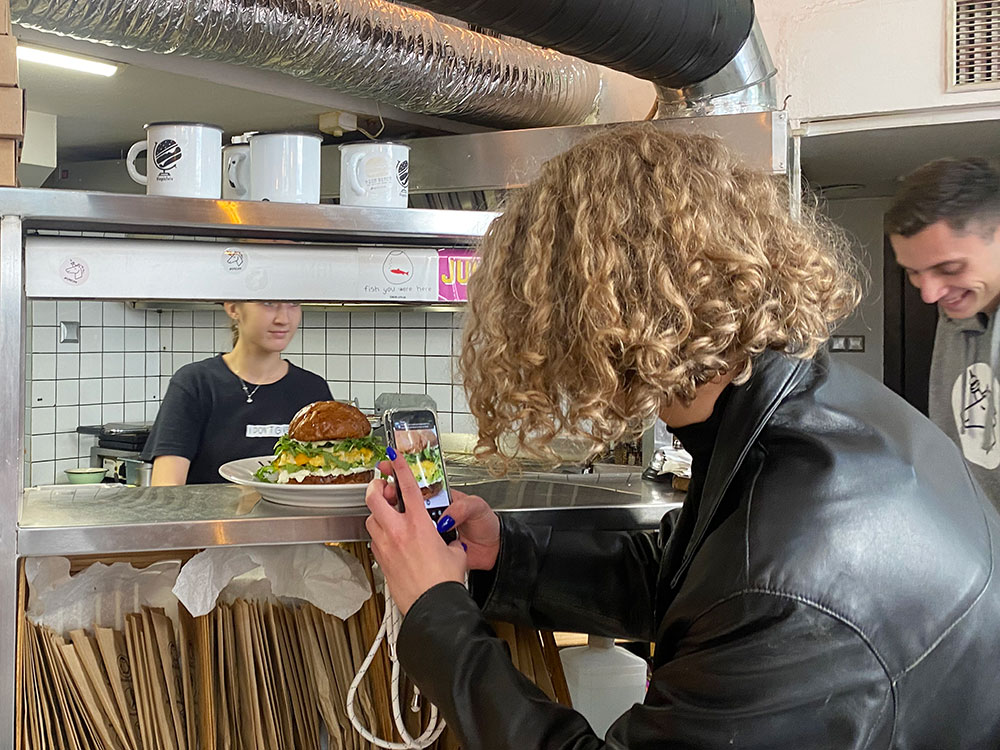
“I have many friends who are programmers for German companies,” continued Varvara, whose half-dreadlocked, blonde bob gives her round face an idiosyncratic beauty. “All good restaurants have this,” she added, tapping my table’s QR code, which brings up the menu on a phone. Most patrons also pay by phone, I noticed.
Another burgeoning Ukrainian business is modelling, I was told by Hanna, whom I also met in Kryva Lypa, at the record and DJ equipment shop Vinyl Club. Two days before, I saw three fashion shoots in Old Town, when it was bathed in golden afternoon light, before the onslaught of autumn rains. Hanna, who is petit and favors the blond-but-approachable look, recently returned from a shoot in Portugal but has modeled all over Europe. “Ukrainian models are popular,” she said, “Because we work hard.” Also playing a part, I suspect, is that Ukrainians are romantic, select for beauty and intermarry.
******
Reader Supported News is the Publication of Origin for this work. Permission to republish is freely granted with credit and a link back to Reader Supported News.
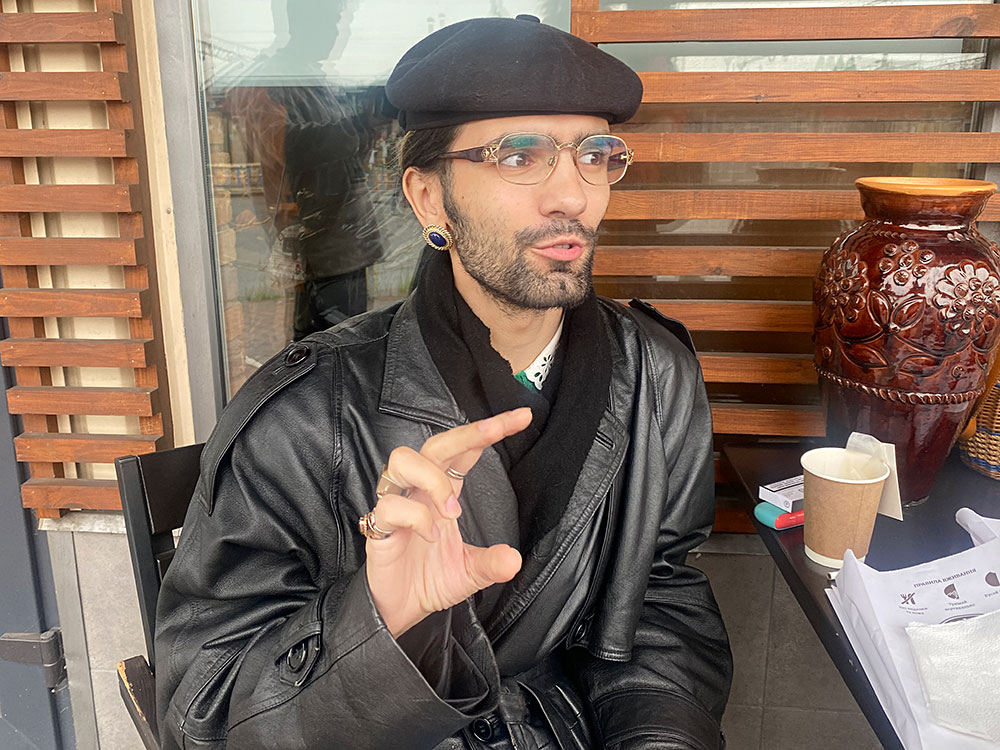
Ukraine’s digital success was also extolled by Rodion, a high-cheek-boned, dark-complected, oft-smiling man, who works as a film costume designer and looks like he just did a shoot himself, given the black leather duster and ornamental earrings he was rocking. I met Rodion, his old friend Catherine, a jeweler, and her teenage son, glued to his phone, near one of Kyiv’s many large, low-rent flea markets, where they were looking for vintage jewelry.
“Everything government related, from getting identity documents to filing taxes, is now online,” Rodion said, over a cappuccino. “It is easy to start a business. Both Catharine and I have our own.” They also detailed how well their socialized medicine works, suggesting Ukraine could become a model for social services as well as free markets and democracy, a socialist-capitalist hybrid achieved on the cheap, given it is still one of Europe’s poorest countries.
“Ukraine has been improving since Zelensky became president,” Catherine said. “I feel like the government cares about me now.”
Out of the blue, however, they began venting bitterly about Russians, even though both are from mostly Russian-speaking families, as were many of the creative people I met. “We speak Russian at home but not on the streets after February 24th,” Rodion explained. “We had to flee eastern Ukraine after Russia’s invasion in 2014—supposedly to save us,” he added, shaking his head and looking grim.
Rodion and Catharine blamed average Russians, not just Putin, an opinion shared by many Ukrainians and dating from 2014, when their Russian friends and relatives, which many Ukrainians have, gloated over social media about Crimea, feelings now compounded by massive war crimes. Adding insult to injury, many of those Russians claim the evidence for those crimes was faked.
“The Russian teachers’ union sent volunteers to brainwash Ukrainian children,” noted Catharine. “Unpaid volunteers?” I asked. “Of course not!” interjected Rodion, “Nothing in Russia is without pay these days!”
At the very moment Catharine, Rodion and I were chatting on September 16th, Putin was at the Shanghai Cooperation Organization summit in Samarkand, Uzbekistan, meeting with the Chinese and Indian presidents, Xi Jinping and Narendra Modi. They told him—Modi to his face—they weren’t happy with his unnecessary war now threatening their economies and world food supplies, not to mention nuclear holocaust.
A week earlier, Kyiv had hosted its first conference since the war, an attempt to understand the war, in fact: the 17th annual Yalta European Strategy summit, named for the Crimean city where Stalin, Roosevelt and Churchill strategized the final defeat of Nazi Germany, in February 1945. A few months before, however, the Soviets had deported to Siberia all the Crimean Tatars, about a quarter million people, half of whom died, a small fraction of whom returned. Ukraine's democracy gave them full legal rights, but that ended with the Russian reconquest in 2014.

Dirk had organized two mini-conferences in Lviv, the second at the Lviv Art Center, which has classes, a small gallery and a nice café. Also about what artists should do during the war, it was attended by Kirill and nine others, including a Tatar-Ukrainian woman in her early 20s. Alem accentuates her wide-set eyes with aggressive makeup slashes, works for NGOs, and lives in Lviv, although she was raised in Washington DC and is also American. “People say it’s impossible,” Alem told us, “But my dream is to liberate Crimea.”
Y.E.S. is the brain child of Victor Pinchuk, an oligarch and philanthropist, who is sometimes called the Ukrainian George Soros, because he’s Jewish and supports culture, but rarely in the crazed conspiratorial sense. Indeed, the Pinchuk Art Center, a half a mile from the Maidan, is universally well regarded. Both Dirk and I found its contemporary collection impressive and its current show, “Russian War Crimes”, a tour de force of artists addressing war, Dirk’s subject. We lingered a long time in the substantial show, including the devastating video in the last room, a hurricane of quick-cut atrocity shots, sometimes using split screens, until we were interrupted by an attendant, who ushered us down to the street due to the air raid.
“Is there a bomb shelter we can go to,” I asked the guard in front. “No need, it was false alert," he said, laughing. "Insurance makes us evacuate everyone and wait for all clear.” “But what if there was an attack?” “The metro is right there and very, very deep.” Indeed, it was built for nuclear war.
In addition to organizing seminars and shooting a documentary in Ukraine, Dirk planned a performance piece. He enacted it on September 17th, in the middle of the Maidan, on the same spot graced by the dancers, which was dry, since it hadn’t rained for over a day. As I filmed, Dirk arranged on the ground 20 posters for the “Kunst Krieg” (“Art in War”) conference he arranged a month earlier in Berlin, each poster emblazoned with the word “cancelled,” since that’s what happened, for reasons he didn’t fully explain. Then he began calling German galleries to reschedule the conference.
The two-day Y.E.S conference was titled “Ukraine: Defending All Our Freedom” and featured banners with “I need ammunition, not a ride,” President Zelensky’s famous quip, which may have been written by his legendary media team. Hosted by CNN’s Fareed Zakaria, Y.E.S attracted to a hardened Kyiv basement some 400 international and Ukrainian notables, including Polish, British and American lawmakers, Google’s ex-CEO Eric Schmidt, who commended Ukraine’s digital prowess, and Professor Snyder, who emphasized the war was colonialist, which Europeans don't quite get, due to their own recent colonialism. Also in attendance was another one of our best and best-selling scholars of Ukraine and Russia, the journalist Anne Applebaum, along with General Wesley Clark, French philosopher Bernard-Henri Lévy and the Azov commander Serhii Tsisaruk.
After welcoming them, Victor Pinchuk noted we were witnessing the final collapse of the Soviet Union—“Dinosaur can take a long, long time to die and, during this time, he will try to drag us back to his prehistoric past”—before introducing President Zelensky.
"Russia is doing everything to break the resistance of Ukraine, the resistance of Europe, and the world,” Zelensky said, wearing his standard khakis and military-green T-shirt. “The 90 days ahead will be more crucial than 30 years of Ukraine's independence. These 90 days will be more crucial than all the years of the existence of the European Union. [This] winter will determine our future.”
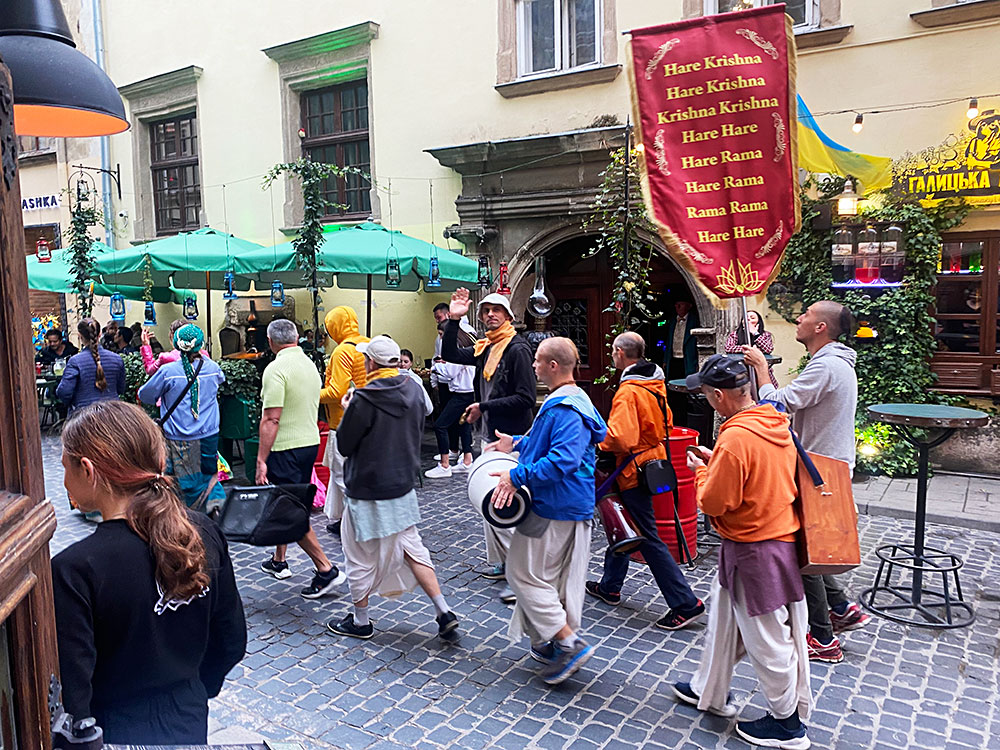
“No negotiations with the Russian Federation regarding the end of the war are possible," Zelensky explained, since “There is no confidence that they will keep their promises.” In fact, Russia's invasion of Crimea and the Donbas violated the U.N. Charter’s Article 2 on sovereignty and the 1994 Budapest Agreement, which was signed by the U.S. and Great Britain as well as Russia and guaranteed Ukraine's territorial integrity in exchange for giving up all of their nuclear weapons. Less well known is the Battle of Ilovaisk in 2014 when the Ukrainians surrendered their weapons for safe passage but the Russians resumed shooting.
While fears of escalation are understandable, appeasement encourages rash action and agreement violation. A few weeks into the war, during negotiations hosted by Turkey, the Ukrainian delegates offered fresh security arrangements: Ukraine would stay non-aligned, Crimea negotiations would be postponed for 15 years, and the 2014 Donbas invasion would be addressed separately. In response, the Russian delegates called them Nazis and offered to withdraw from Kyiv, where they'd already been repulsed.
“We must fight," Zelensky continued at the Y.E.S. conference, articulating his ascent as Europe’s de facto wartime commander. “Endure the winter. Help those who are weaker. Protect those who need protection. Limit ourselves in what can be limited. And limit Russia in everything that should limit it. The unification of Europe is impossible without Ukraine." Most Ukrainians have wanted to join the E.U. for decades, and they even amended their constitution to that end in 2019. “It will be an honor for Europe to welcome our state," Zelensky concluded, "The state that wins!"
Dirk’s performance goes well. Standing in front of his colorful pile of “Kunst Krieg” posters, he calls the galleries, introduces himself politely and leaps into action—“You remember the Maidan Revolution, eight years ago? I am standing on Maidan Square right now!”—before asking if they can host a one-session conference on artists and the Russo-Ukrainian war. After chatting with a baritone gallery owner, Dirk grins at me, shouts something unintelligible, and starts cleaning up. It takes him three trips to haul away the paving stones he used to hold his posters down in the autumn breeze and, eight years ago, the kids of Maidan lobbed at police.
As I pack up the camera tripod, sliding its legs together, it dawns on me: “I take the train to Lviv tomorrow, so this is my last time on the Maidan.” I look around: Berehynia smiling down from her column, the multi-colored pigeons (black, white and mottled), the smattering of Kyivers going about their day, and the regulars, the yellow-blue wrist-band vendors and two tourist-photo hustlers, one wearing a cartoon horse outfit, the other covered with tattoos and carrying two large, white show pigeons, to whom I nod, since I got some photos earlier.
“What an incredible place, a cool architectural space, a symbolic place,” I muse, until I work myself up and start yelling to myself: “In the middle of a fucking genocidal war, the goddamn Ukrainians are so democratic, they don’t mind anyone coming to their central square and saying whatever the fuck they want—including the likes of Dirk, a half-crazed German performance artist!” During my five or six times on the Maidan, in fact, I don’t recall seeing a single soldier, police officer or even untoward stare.
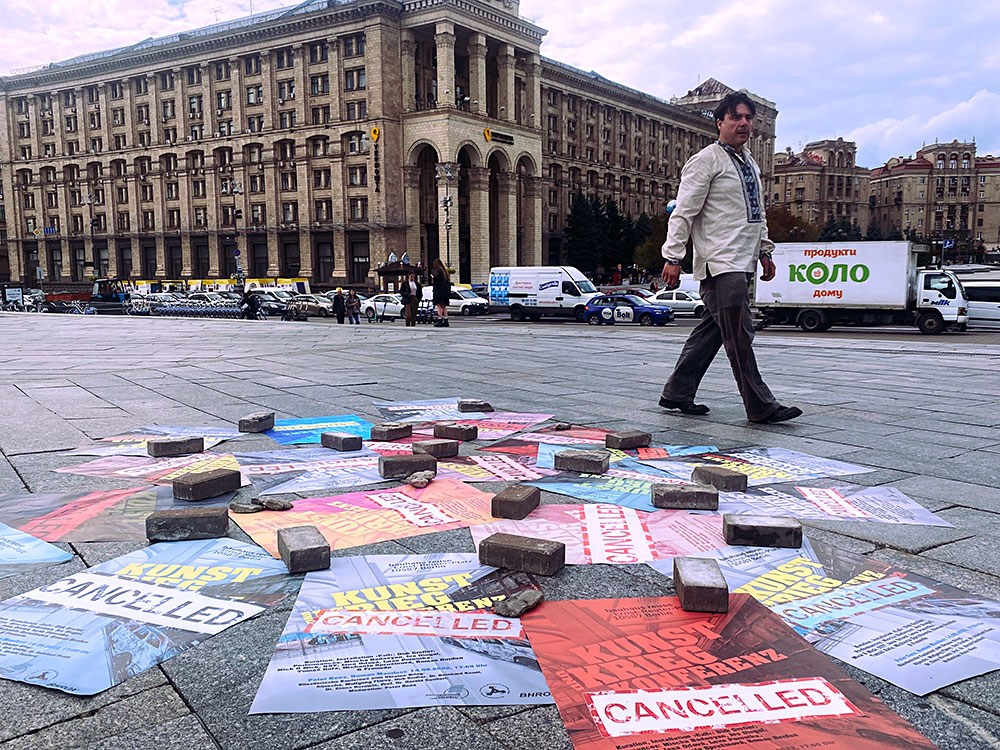
The next day, Dirk and I bade each other adieu with repressed emotions. Suddenly involved in each other’s lives—we also took meals together and roomed in a deluxe, rococo one-bedroom on Pushkin Street ($24 a night and four blocks from the Maidan!)—we were unable to understand what that might mean in the middle of our generation’s most destructive and divisive war, now slicing through countries, ideologies and friendships as well as mass murdering Ukrainians.
It was 1 a.m. by the time I hit Lviv. The cabbie raced the three miles of curfew-cleared streets from the train station to downtown, which is next to Old Town, where I had a spartan room in a 19th century building. In Ukraine, what that usually means is the building's entrance, stairs and hallways are falling apart—a comment on undemocratic collectivism, perhaps—but, once inside an apartment, they’re nice, large, luxurious even, having been renovated by the actual owner. At Kirill’s, for example, which he rents for the equivalent of 400 bucks, we walked up three flights of decrepit stairs, along a pealing balcony, and into a lovely, high-ceilinged duplex with a wrought-iron staircase, which leads to a big bedroom with a claw-foot tub and view of the city.
And spotless. Ukrainians are hygiene freaks who take their shoes off at home and in some businesses, like dental offices, and put on slippers or disposable shoe coverings.
Donning my slippers and stumbling down the dark hall, past five other rented rooms, I was happy to see my small room and tiny bed, which obliged my toes to stick out the slats at the bottom, as well as the chair, desk and large window, which looked out on Kryva Lypa, Lviv’s well-known courtyard crammed with cafes, now deserted during wartime at 2 a.m.
Kryva Lypa means “crooked linden tree,” which is still here, three stories tall, right beneath my window and surrounded by a circular, wrought-iron bench often occupied by women laughing, hipsters arguing, parents rocking kids or soldiers enjoying peace. Instead of the tourist trap I had assumed Kryva Lypa to be, when I moved in, it’s an old bohemian hang- and hide- out, protected by its two access tunnels, which can be easily blocked. Indeed, Kryva Lypa is where Lviv’s first movies were shown in 1903 and hippies and punks first congregated.
An eight-foot, punk-era turntable sculpture still hangs in the brew pub Bratyska (“bratyar” means brothers), which features 30 beers on tap, including a tomato one I didn’t try, and a famous borscht I did, every day for a week, in fact, after catching a cold. Prepared daily by Pani Lida (“pani” means missus), the no-nonsense, middle-aged woman I saw taking smoke breaks on the front porch, the borscht was both tasty and had great sides: cloves of garlic and slices of onion and pig fat, in addition to the standard sour cream and dark bread. No wonder Bratyska is so popular with college students, especially from the National Academy of Art, two miles away.
“I’m taking the interior design curriculum but hate, hate it,” said Pauline, whom I met on Bratyska's porch and is tall and stunning, despite the acne she doesn’t hide with makeup. “It was the only department I could get into with my small portfolio. I only draw or paint sometimes. My passion is performance art.” “Oh, that’s cool,” I effused, trying to seem so myself, “A friend of mine just did a performance on the Maid—” but Pauline interrupted me. Her friends from the Academy, easily recognizable by their distinct dress and greetings, had arrived.
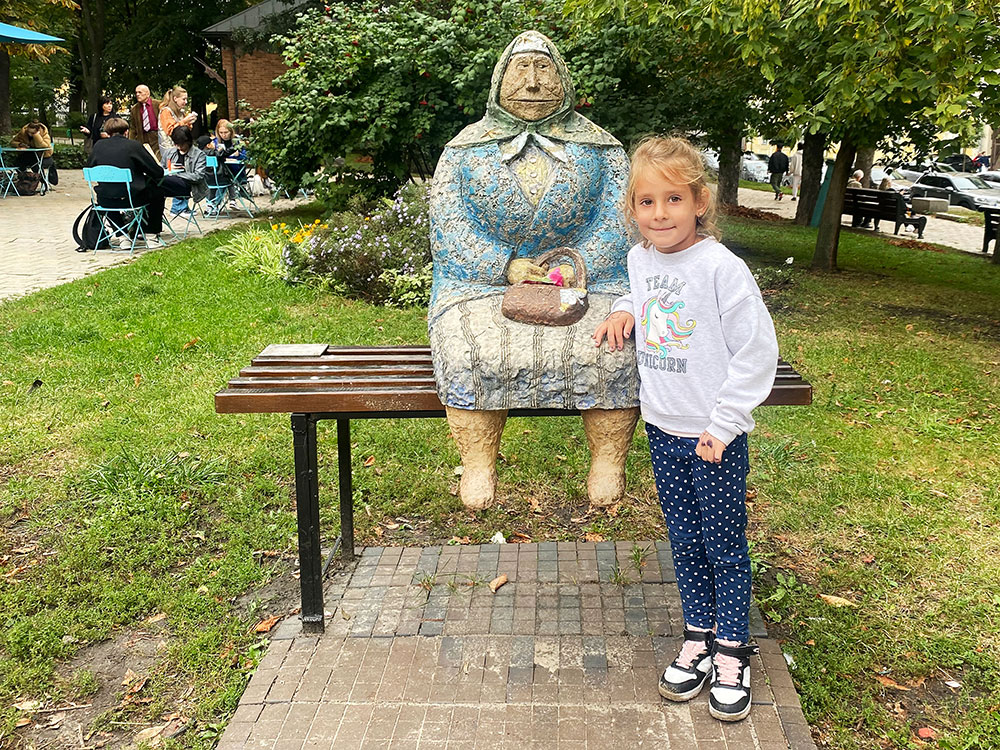
Next to the Bratyska was a well-appointed nightclub and jazz venue, which just reopened as a comedy club. “Lviv’s fourth,” I was told by the ticket taker, a twenty-something Ukrainian-American woman raised in Sacramento, which is near where I live in California, who moved back after the war started. “What can I say? Ukrainians love comedy,” she explained. “People under threat of death need humor?” I offered, " Perhaps the gallows humor thing," and, “Or they’re honoring Zelensky,” which finally got a laugh.
In fact, Zelensky did do standup around Kyiv, Ukraine and Russia, where he also acted in a number of films, including playing Napoleon in the Russian comedy feature “Rzhevsky Versus Napoleon” (2012). Although poorly reviewed and a box office flop, the film’s kooky plot or mere existence suggests that conquering Ukraine was not foremost on most Russians' minds at that time. Meanwhile, Zelensky’s experience in Russia, from being a comic on the road to a more respected actor or his one meeting with Putin, provided him invaluable insight.
“We know for sure that we don’t need the war,” Zelensky pleaded with Russian listeners, during his February 23rd, eve-of-destruction broadcast. “Not a Cold War, not a hot war. Not a hybrid one. But if we’ll be attacked… if they try to take our country away from us, our freedom, our lives, the lives of our children, we will defend ourselves."
"You are demanding security guarantees from NATO, but we also demand security guarantees. Security for Ukraine from you, from Russia and other guarantees of the Budapest Memorandum. [If there is war] nobody will have guarantees of security anymore. Who will suffer the most from it? The people. Who doesn’t want it the most? The people! Who can stop it? The people. But are there those people among you? I am sure.”
Across from Microbrew Bratyska, in one of Kryva Lypa’s access tunnels, is one of its lesser lights: Dizzy Coffee, a tiny shop with two tables and a small upstairs loft but a powerful interior design using Piet Mondrian's colored squares. After my late-night return from Kyiv, I dropped by Dizzy for a quick cappuccino but got into an in-depth discussion with the barista, Andrii.
Thin, dark haired and 23 years old, with a sweet face beneath a light beard, Andrii has a degree in economics and a penchant for machine-gun-fire speech and wild gesticulation. As I learned over the next few days, Andrii is the elder in a crew of voracious-reading, pop-culture-consuming and debate-loving kids, who also listened to their grandparents. It was Andrii, in fact, who informed me of the Holodomor’s three rounds—1932-3, ’45 and ’46-7—hands flying around the espresso machine for emphasis but not spilling a drop.
“My grandmother worked in bakery,” Andrii said, during our first chat, which went high speed between coffee customers for over an hour. “Soldiers came every day and took 90 percent of bread. It’s a problematic. It goes for few years after war.” The Soviets also murdered almost 300 Ukrainian writers in the 1930s—"They are called 'executed renaissance,'” he told me—and kept killing intellectuals into the ‘70s.

“She was Jew, Holocaust survivor from Warsaw,” Andrii added about his mother’s mother. “Her name was Mandelbaum, popular Jewish name,” although his family didn’t find that out until perusing her papers after she died. As it happened, her husband was a member of the fascist Organization of Ukrainian Nationalists, who had been arrested and did time in Siberia before they met.
“Did they know each other’s stories?” I asked. “They must have,” Andrii said, “They lived together for many years.” “Did they love each other?” “They must have, they had four children.” “Is your mother loving?” “Yes.”
Somewhere around then, into Dizzy’s cramped confines strode Andrii’s best friend, Vasyl, 22, all boots, skinny jeans and unkempt, curly black hair. A programmer for a German company, who does comparatively well, I learned when he told me about his life two weeks later, Vasyl grew up poor in one of the Soviet-style apartment blocks that speckle the suburbs of eastern bloc cities. When he was sixteen, he worked in a factory for eight months, learned not to romanticize proletariat life, and bought his first computer. He also plays classical piano, loves heavy metal and punk, often reads or listens to books on tape, and writes poetry. Andrii writes prose. Vasyl also told me about his grandparents, speaking almost as fast as Andrii but with less gesticulation.
“He was very, very against war,” Vasyl said about his grandfather, Mykhailo (Michael in Ukrainian). “He was born few years before the Great War and saw many terrible, terrible things as a kid: dead people, dead animals, bombed buildings, bombed streets, bombed whole cities, etcetera, etcetera, etcetera”—Vasyl’s trademark expression in English. Andrii’s is “problematic,” used as a noun.
“He wrote it all in his memoir, which I read, which was hard to read, because it is written by hand and had many strong statements. Some too strong for publication,” although that could be cleaned up by his daughter, Vasyl’s mother, a book editor. “He died last week,” Vasyl added, to which I offered condolences. “He had good life. He was 85. We will have cemetery thing on Sunday.”
Vasyl’s parents are religious, which is how many older Ukrainians addressed the terrible trauma of Soviet and Nazi totalitarianism and genocide, although his mother is Jehovah’s Witness. “It was her way of rebelling against grandfather, who was Orthodox,” Vasyl explained. Somewhere in there, he noted that, “She and I are the only ones in our family to graduate from university,” although Mykhailo was a renown building crane operator.
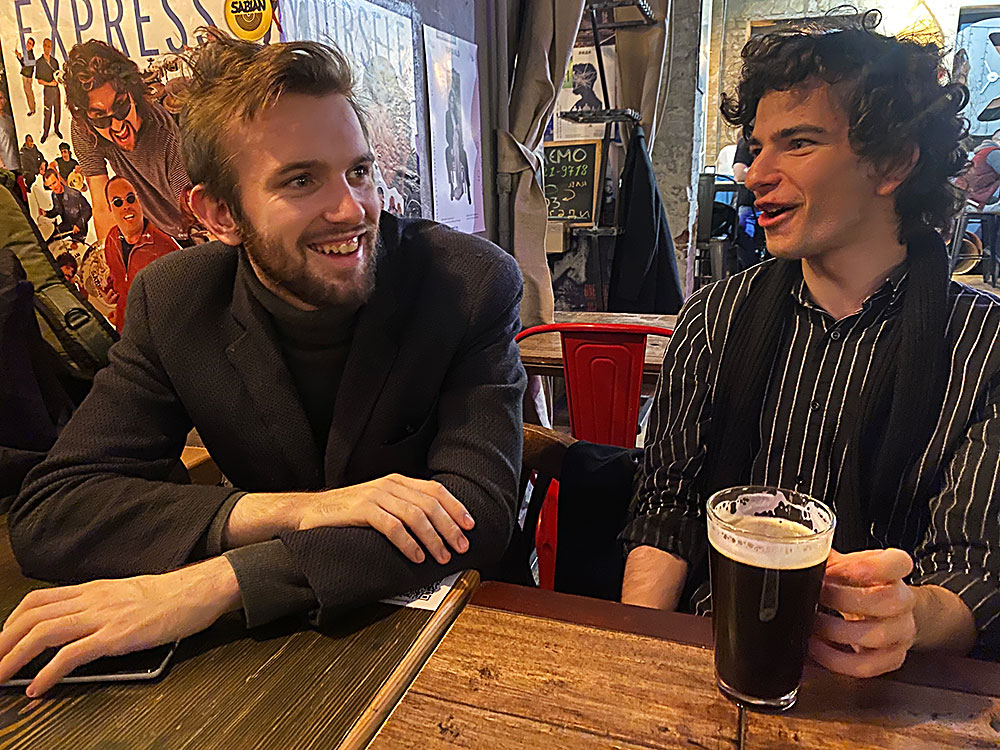
“When the war started, Grandfather thought we should surrender, surrender right now, surrender as soon as possible,” Vasyl said, getting excited. “‘We are going to lose anyway,’ he kept saying, ‘And that will stop killing.’ But after a week, Grandfather changed his mind. ‘We have to fight,’ he said, ‘To stop killing in the future.’”
Andrii tried to enlist in the Ukrainian Army but was rejected and did extensive volunteer work near Kyiv. Vasyl didn’t bother, since he’s been plagued with health problems since childhood and figures he can contribute more in other ways. What he calls his “homemade NGO” recently bought a car, 70 pairs of socks and some shoulder bags for rocket-propelled grenades, which a friend drove across Ukraine to “their unit.”
For the next three weeks almost daily, Andrii, Vasyl and I embarked on a broken-field run across Western civilization, from “The Bible” and Plato to Poe and Crowley, the filmmakers Lynch and Tarantino, or the philosophers beloved by twenty-somethings worldwide: the Slovenian leftist Slavoj Žižek and the innovative evolutionary psychologist but also rightwinger from Canada, Jordan Peterson, both of whom Andrii and Vasyl find interesting but too extreme. One of them, I can’t remember which, read and enjoyed “Tropic of Cancer” by Henry Miller, the other Gregor Von Rezzori’s “Memoirs of an Anti-Semite”, two of my favorite books.
We lingered over Mikhail Bulgakov’s “The Master and Margarita”, which I hadn’t read, I was ashamed to admit, but knew of as the great farce of Russian literature. Bulgakov was from Kyiv, it turned out, and fought in the Russian Civil War, first for the czar, then the nationalists. His satire is so dry, according to Andrii and Vasyl, critics are still arguing whether Bulgakov was sending up or supporting Stalin.
“Satire doesn’t work with conspiracy theorists, because they take it literally,” I pointed out. "Are you familiar with ‘The Illuminati! Trilogy’ by Robert Anton Wilson?” “No,” said Vasyl. “It’s about a secret group called the Ill—” “We know about Illuminati!” “OK, great, and how ‘bout QAnon?” “Of course!” “Anyway, Wilson, he was only joking about the Illuminati, which is why he put an exclamation point in his title, but readers believed him anyway. Actually, he was trying to put people off believing in conspiracy theories, like McCarthyism... the communist scare in the '50s?" "Yes, yes, we know about McCarthyism!"
“We don’t worry about such bullshit!” interjected Andrii, “We have too many conspiracy problematics from Russia.”
At any moment, of course, we would switch to breaking news or reports from the front, which I was now getting from an American with a literary bent and checkered past who was fighting with the Ukrainian Foreign Legion near Kherson. Paid the same as Ukrainians, foreigners can reject orders or quit fighting. Over hours-long phone calls—one of which Vasyl listened in on—or text dialogues, Terry, 53, from upstate New York, regaled me with pithy stories about firefights or his international comrades: the short, gorgeous Norwegian of tribal Sana heritage, who was tough as nails and drove a Porsche, the Jewish woman medic from Texas, who hauled a wounded man almost twice her size to safety, or his close friend Paul Kim, 1997-2022, whose death devastated him. A Korean-American from Oklahoma, Kim was a dedicated democrat, an up-for-anything warrior, and perhaps the first ex-US military officer to die in the Russo-Ukrainian War.
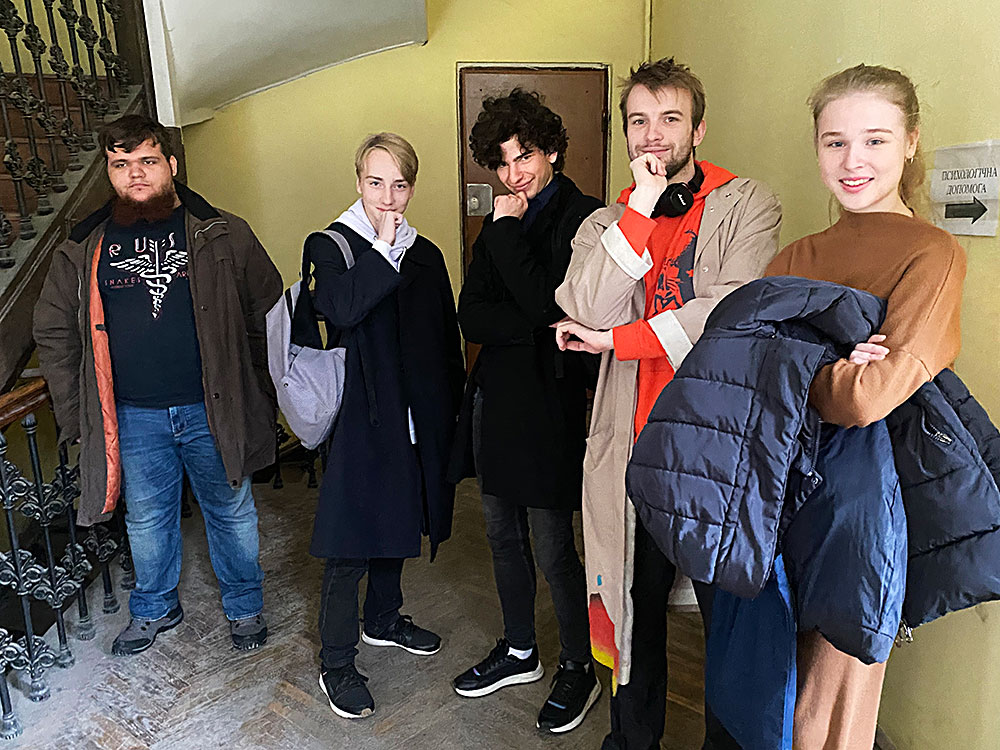
Or we’d analyze Putin’s psychology, that of the leftists supporting him or the rightwingers opposing him. After beers at Bratyska one night, we retired to my meagre quarters, and Vasyl delivered a dissertation on Ukraine’s neo-Nazi punks: how they emerged from the punks of Russia, a society defined by its anti-Nazism, which makes those symbols an easy way to rebel; how a popular Russian punk musician moved to Kyiv and developed a following; how they want to destroy the state, like anarchists, not strengthen it, like actual National Socialists; and how it was better to keep talking to them rather than letting them stew in alienation.
Stepping into Dizzy once, I found it empty except for Andrii and Vasyl arguing loud and fast and gesturing wildly. “What are you debating?” I finally interrupted. “Equality of opportunity versus equality of outcome,” Vasyl said. “Which side are you on?” “Equality of opportunity.” “So Andrii is still a leftist?” “Sort of.” “Does Dizzy’s owner ever worry you’re driving away customers?” “No. He sits right there,” said Andrii, pointing to where I had seen a quiet, amiable fellow, by the name of Volodya, Vasyl told me. “I buy a coffee or two a day,” he added, “As do all our friends, which keeps Volodya in business.”
Indeed, Dizzy was often half full of their friends, working on laptops, chatting quietly, debating loudly or getting caffeinated. They were mostly young women like Maria, a sweet, smart and hardworking translator, to whom Vasyl would call out mid-sentence for help with a word in English, Anya, the elegantly-dressed, redheaded photographer, who did their photo shoots, or Zosia, an artist, graphic designer and adventurous spirit as well as Dizzy’s weekend barista, who once told me, “Lviv is all hippies."
Some of them were helping Andrii and Vasyl on their new magazine, Фрайдей найт. Pronounced “fraydey nayt” and meaning Friday night, it references an older magazine, Четвер (“chetver” meaning Thursday), edited by a popular modernist writer from the Carpathians, Yuriy Izdryk. Friday Night's logo—a slab of meat taped to a Ukrainian embroidery, a la Maurizio Cattelan’s "Banana" (Art Basel Miami, 2019)—was designed by Andrii’s girlfriend, Stasia (short for Anastasia), who is talented, bright-eyed, beautiful and, it so happens, blonde, and may be all of 20.
“Andrii will do more editing and content creation,” Vasyl said, “And I will do tech and funding. We will focus more on ideas, poetry and philosophy, etcetera, etcetera, etcetera, since war is already discussed everywhere.” The first issue will probably be printed in February, they told me, and be accompanied by a social media presence.
Some of Dizzy’s denizens were only 16, I was surprised to learn, and still in high school, where they’d read but didn’t quite get Dostoevsky or Tolstoy, one admitted to me. A few joined the debate club Andrii and Vasyl attended and toured with around Ukraine. They invited me to the club once, which met weekly at a youth center across Old Town, and debated in English, so I could participate. Watching Evelina, a tall, innocence-exuding, almost albino-blonde 16 year old defend the proposition “Is nostalgia beneficial?” in high-speed English—on top of hanging around Andrii, both her parents are lawyers—I thought, “My god, the kids of Maidan are getting younger, fiercer and more articulate!” No wonder Putin is petrified.
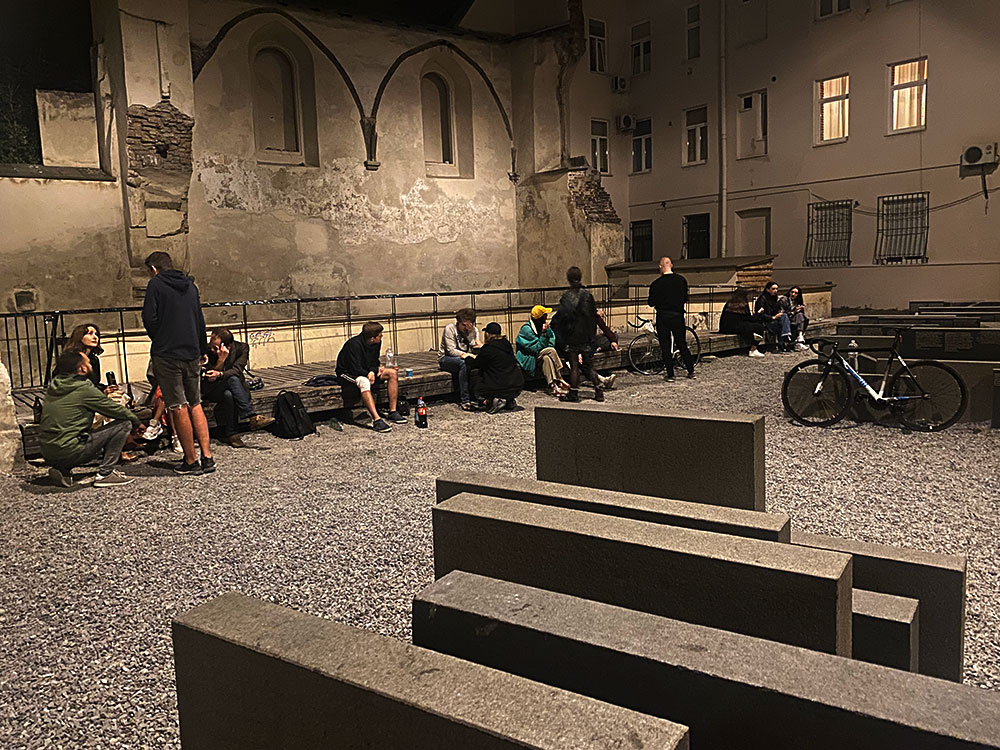
The next day, September 26th, was Rosh Hashana, the beginning of Judaism’s high holy days, which I usually honor by going to a synagogue for a few hours, even though I'm agnostic. Although Lviv has one synagogue left, the Beis Aharon V'Israel, near the train station, which has been run for the last three decades by a lovely New York Hasidic rabbi and his wife, I decided to tour the city’s synagogue ruins, of which there are many. After searching online and extensively on the ground, I found the weathered plaque marking the largest, the Great Synagogue, now an empty lot with a small playground but a majestic colonnade of trees. I also found the Tempel Synagogue, no sign but again an empty lot, which suggests some respect for the half millennium when Lviv was almost one third Jewish.
Then I headed to my favorite, the Golden Rose Synagogue in Old Town, a wonder of medieval architecture from 1582 until August 1942, when the Nazis destroyed it, except for the floor and back wall. Aside from the memorial for the Jewish ghetto, which has a nice park on a main avenue with a menorah and large sculpture, the Golden Rose is Lviv's only Jewish memorial. It features extensive explanatory signage, in Ukrainian and English, and a modest row of waist-high black stones engraved with photos and quotes. One stone has a famous 17th century rabbi, Joel Sirkis, declaring, "[Lviv is] a grand and glorious city, full of scholars, writers and teachers... the source of wisdom and foundation of prudence."
In addition, for the last 30 years at least, the Golden Rose has been a hangout for teenagers, perhaps because there’s no one to chase them away. In all kinds of weather or times of day, up to a hundred kids of Lviv are at the Golden Rose, playing music, goofing around, flirting and drinking, sometimes to excess, sometimes relieving themselves in the destroyed sanctuary, since no toilet is readily available.
They breathe life into old stones, I find, which is why I had already visited the Golden Rose three or four times. And why I spent a few hours there the afternoon of Rosh Hashana, gazing into its grassy remains, reading about the Jews of Lviv and their annihilation, and thinking about my own mistakes and trespasses during the last year, which is the spiritual assignment of the last day of the ten-day holiday, Yom Kippur. "Were there any major errors I was missing?" I wondered.
The kids didn’t pay me much mind, despite my being over three times their age, until I felt a presence behind me: a short, stocky young man. Speaking decent English, Valter, 23, a soldier on leave from fighting near Kharkiv, invited me to drink with his buddies. I begged off, explaining I’d rather not since it was a Jewish holiday, but he kept repeating his invitation and, somewhere in there, noted his grandfather was a Nazi.
“A Nazi from Germany?” I asked, incredulous. “Yes,” Valter said. “Was he an OK person?” “Yes.” “Did he give you candy as a kid?” “Yes.” “Did he treat your mother well?” “Yes,” he said and added, tentatively, “It is weird. My grandfather fought the Russians. Now I am fighting the Russians.”
I looked into Valter's unassuming gaze. Facing physical death or the moral dilemma of dehumanizing the enemy is not a walk in the park at any age. Indeed, my Foreign Legion contact, Terry, tough as he claimed to be and over twice Valter's age, mentioned both of those difficulties. Finally, I said, “It’s good you are talking about it,” and gave him a hug, which he accepted. “Keep talking about it, I would say, just keep talking about it.”
Valter’s friends were Oras, six-foot-seven, about 20 and with an excellent command of English; Adriana-Maria, younger and blonde, who poured me a paper cup with some hard alcohol and an energy drink, which I held but didn’t sip, and two 14 year olds, Ruslan and Nazar, who attended high school nearby. The nattily-dressed and dark, shoulder-length haired Ruslan didn’t speak a word of English, but the skinny, scruffy and nerdy Nazar did, expressively if haltingly. Ruslan and Nazar seemed to be enjoying Lviv’s dreamy, vibrant youth scene, even in the middle of a deadly, disastrous war, which Valter must have had told them about, and to which they may have to eventually go.
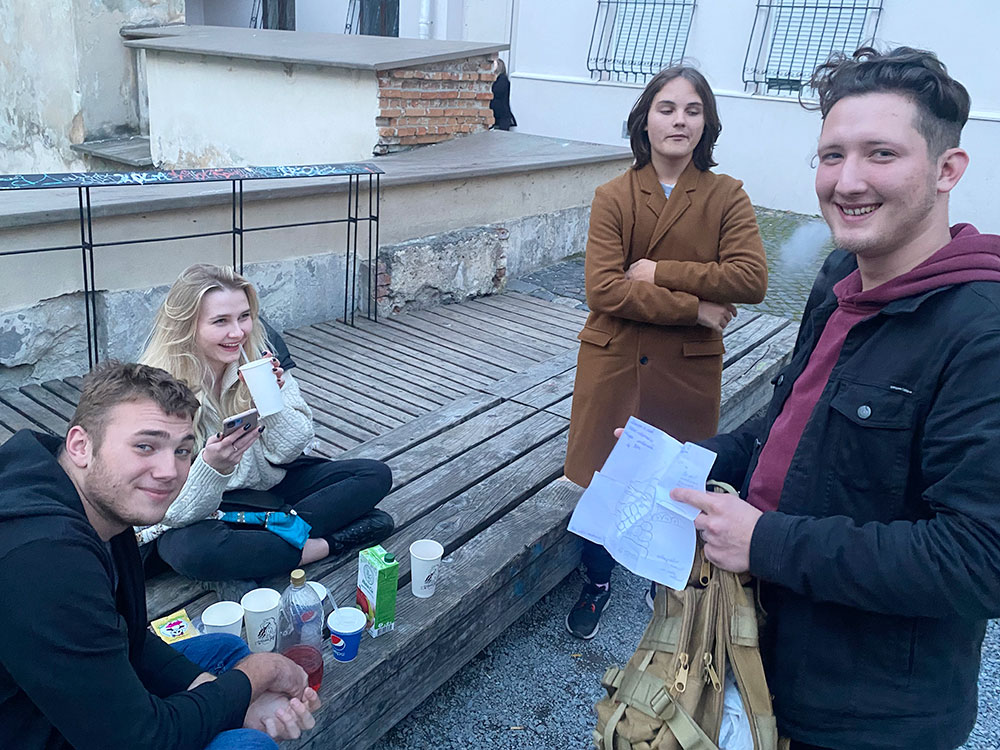
Indeed, beyond the Golden Rose Synagogue, a brutal geopolitics was unraveling with alarming alacrity:
• Six days earlier, on September 20th, President Zelensky addressed the U.N. Assembly by video. “What is not in our formula? Neutrality,” he said. Later, he asked, “Why [is] the Russian military so obsessed with castration? What was done to them so that they want to do this to others?” but ended on a hopeful note. “We decided to provide humanitarian aid to Ethiopia and Somalia… additional amounts of our wheat.”
• The next day, Putin ordered the immediate mobilization of 300,000 soldiers and repeated his big lie: Russia will “liberate [the Donbas] from the neo-Nazi regime, which seized power in Ukraine in 2014 as the result of an armed state coup.” Russia will also defend itself, including territory incorporated after the upcoming “referendum,” by any means necessary, he said, voicing yet another nuclear threat, which started on February 28th, when Russia’s nuclear forces went on high alert.
• Within hours, there were arrests, riots and shootings at Russian draft centers, including authorities by draftees. Mostly non-Russian, they were well aware they will become part of the standard Russian strategy of throwing large numbers of troops against better -trained and -equipped opponents. Within days, up to a quarter million military-age men had fled Russia, choking airports and border crossings from Finland to Kazakhstan.
• On September 24th, the so-called referendum "asked" Ukrainians in Russia-controlled territory whether they wanted to become Russian, with soldiers going house to house coercing votes, even from 13 year olds. The same day, Zelensky announced that surrendering Russian soldiers “will be treated in a civilized manner, in accordance with all conventions,” while a United Nations panel reported that Russians had tortured civilians and raped children.
• Four days later, the referendum passed by a supposed 97% and, the following day, a video went viral of a Russian soldier surrendering after finding himself at the front without proper equipment, three days after being drafted off a street in Moscow.
• On September 30th, the Kremlin celebrated “Ukrainians rejoining the motherland” in Moscow’s Red Square with pop music performances, a military spectacle and speeches. “Western elites deny national sovereignty and international law," Putin said, using the common conspiracist trick of accusing enemies of one’s own crimes. "Their hegemony has a pronounced character of totalitarianism,” he claimed before calling on Kyiv “to end the war that they unleashed back in 2014.”
• That same day, Zelensky stood on a Kyiv street empty except for a small desk on which he signed Ukraine’s official application to NATO.
That same night, the last one of September and a Friday, coincidentally (considering Andrii and Vasyl's magazine), the rain pisses down, as it has almost constantly for three weeks. I think of the soldiers. It must be brutal soaked to the bone, trying to move through swollen streams and muddy fields, especially when on the attack, as many Ukrainian fighters have been since a few days before the deluge started on September 10th.
My room is cold, and I have a bad cold, although it’s not Covid, I know, since I just took a test. Ukraine did not miraculously escape the pandemic, as it sometimes seems, it's just that Covid's mortal threat is far overshadowed by that of war. Hence, no one mentions it, unless someone actually gets sick, and only one in a thousand on the street masks.
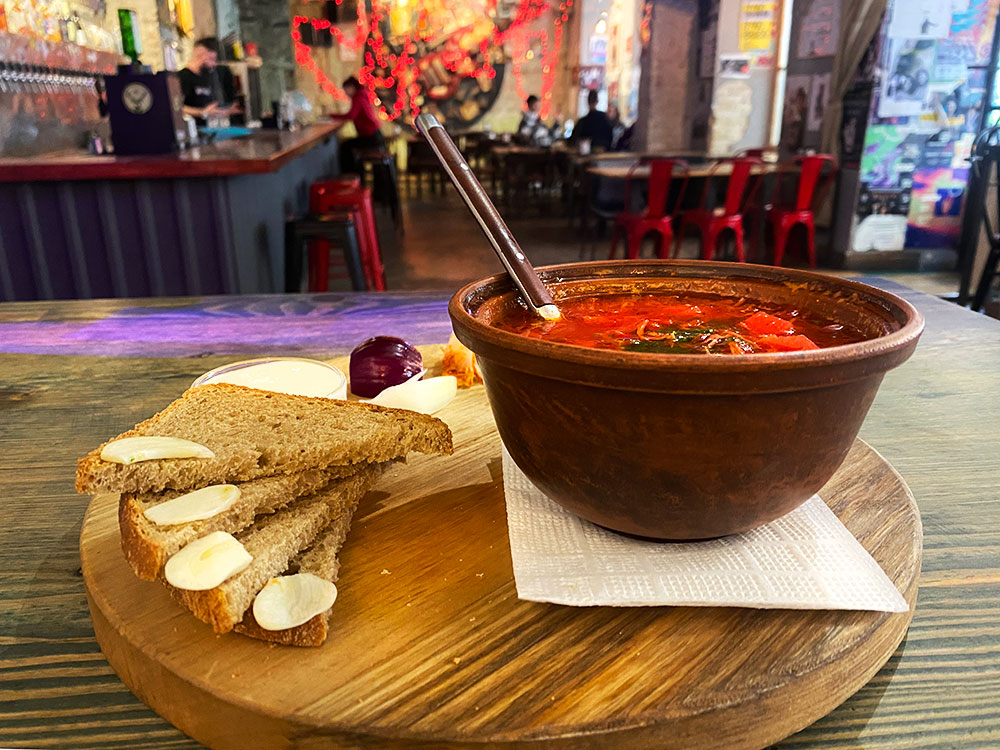
The sirens start around midnight and howl for a half an hour straight, longer than the four or five other air raid signals I've heard in Ukraine. “Does that mean a real attack?” I text Andrii on Instagram, their preferred communication platform. “It’s bullshit,” he responds. “Should I go down to the basement?” “No. You will get sicker.”
The sirens wail intermittently until 4 a.m., long enough for me to entertain dark-night-of-the-soul scenarios: What if the Russians bomb Kryva Lypa to punish Ukrainian free thinking at one of its sources? “Kryva Lypa is old. Its buildings have big walls,” Andrii said earlier that day, tapping a wall, “Only direct hit breaks this.”
It strikes me as tragic but also absurd and then disgusting and grotesque that my new friends and I, the community of Kryva Lypa, the people of Lviv, the people of Ukraine, a burgeoning, nation-building democracy, are now ensnared in a modern, mass-murderous war.
“It is already World War Three,” according to some Russia analysts, like the preeminent English-American Fiona Hill, who was Trump’s Russia expert but provided damning testimony at his first impeachment, which was all about Ukraine, oddly enough. Indeed, it concerned Trump’s attempt to blackmail President Zelensky, whom Trump considered corruptible, but then Trump's exposure as corrupt by a Ukrainian-American, ironically, the U.S. Army intelligence officer Alexander Vindman, who listened in on Trump’s “perfect phone call.” Trump's scam—to withhold essential weaponry until Zelensky enacted or merely announced a phony investigation into President Joe Biden's son, Hunter, who was paid $11 million from 2013 through 2018 by the Ukrainian company Burisma—was probably suggested by his so-called Ukraine expert, Paul Manafort. Trump and company also repeated Kremlin conspiracy theories like Ukraine is not a real country, it is the most corrupt country in world, and it, not Russia, hacked the Democratic National Committee's emails in 2016.
Putin has worked with conspiracy theories his entire professional life, first as a K.G.B. agent, then as president. Shortly after his appointment, in fact, he blamed Chechens for the highly suspicious Moscow apartment bombings of September 1999 in order to start the Second Chechen War. Wars work well with the conspiracist formula that reality is an illusion, enemies are out to get us, and only I can save you.
“In my opinion, the reason [Putin is] at war in Ukraine is not a fear of NATO enlargement or because he’s trying to build a bigger Russian empire for his legacy,” remarked William Browder, who is from a famous leftist American family but became the biggest hedge fund manager in Moscow until he crossed Putin, on Ukrainian television (10/22/2022). Instead of following the zeitgeist shift to post-modern kleptocracy, Browder blew the whistle on corruption. After he was almost extradited to Russia from Spain, on a phony Interpol warrant, Browder developed the Magnitsky Act, which was adopted by the U.S. Congress in 2012 and then by Canada and the European Union. It facilitates the sanctioning of foreign officials who violate human rights, and the freezing of their assets, and is named for Browder's close friend and lawyer, the Ukrainian-born Sergei Magnitsky. In 2009, the F.S.B., the successor to the Soviet-era K.G.B., arrested, tortured and killed Magnitsky.
"I think he’s at war because he’s a dictator who has stolen so much money over the last 22 years from his people that he’s afraid the whole thing will explode,” Browder concluded. “I believe he started this war in Ukraine, very simply, to distract his people away from him towards essentially a fictitious enemy, the Ukrainian people.”
“After Crimea, his popularity was at 90 [percent] and so life was good for Putin,” noted the Russian economist Sergey Guriyev, now living in France (Global Economy Meeting, 1/12/23). “Then it started to come down—because of raising retirement age, because of pretty successful anti-corruption campaign, and social media campaign by the opposition, so his popularity came to 60 again—and so he thought it was time to do something like 2014, something like Crimea.”
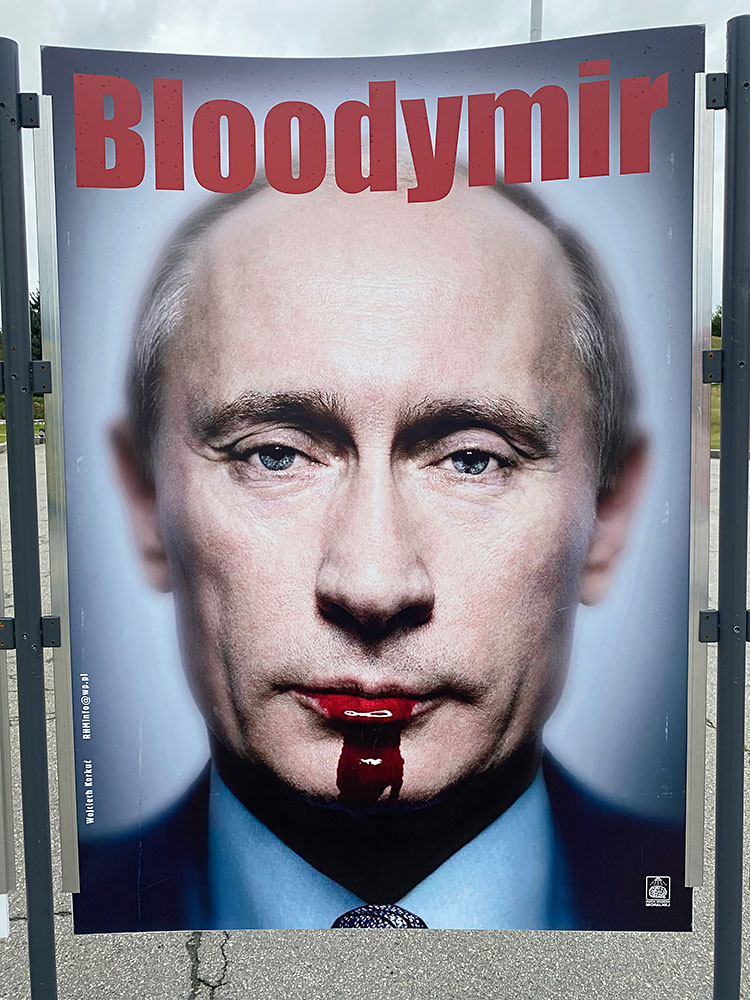
Donald Trump has long allied with Vladimir Putin and other conspiracy theorists and promoted false narratives, from birtherism to election denial, but some of his followers have tired of the deceit, as indicated by Republican losses in the midterm elections. Putin, however, has state media and police and military power at his disposal, plus 70 years of classical Soviet indoctrination and 20 years of the modern Russian version. As it happens, the former's noble fantasies, propaganda and double speak was easier to deprogram than today's cyber-powered cynicism, grievance-baiting, what-about-isms and conspiracy theories, which complement the ubiquitous graft. The Kremlin elite believe they have crafted a powerful enough narrative and gravy train and conned enough people, in Russia and abroad, with the big lies of "Ukraine is Nazi" and "America overthrew Ukraine and is using it to destroy Russia," to legitimize yet another one of the region's prolonged bloodbaths, either in a years-long war or nuclear attacks.
As dawn breaks over Kryva Lypa, I finally realize what's been bugging me since Rosh Hashana.
When I was 12 years old, I did a school presentation about and solicited donations for Biafra, where two million people eventually starved to death in Nigeria’s civil war (1967-70). In 1983, I started reading the history and literature of the Holocaust and attending conferences, in an attempt to heal myself, my family and my community. To a limited degree, I spoke out about the genocides in Bosnia and Rwanda, as I wish more people had for European Jewry. My first published piece, “Interview with Bruno Lowenberg”, was about a Berlin bookman and survivor of Dachau and won a North-West Journalism Award (1983). I co-created “Our Holocaust Vacation” (2007), a documentary about my family’s return to Poland with my mother, Tonia Rotkopf Blair, an Auschwitz survivor, which showed on PBS, and I edited her book, “Love at the End of the World: Stories of War, Romance and Redemption” (2021, Austin Macauley).
But I neglected Ukraine.
As the first of October brightens into a gray, rainy day, I realize: Not only did Obama and Merkel drop the ball on Ukraine, I had. When Russia voided the Budapest Memorandum, by invading Crimea and the Donbas, there should have been more governmental sanctions—if not military intervention or at least arm shipments by the Memorandum's signees—but also people protests. That I didn’t recognize Ukraine's Woodstock-nation moment in 2014, nor its harsh repression by a colonialist overseer, or that I can't even convince some of my hard-left friends that is what has happened—even after telling them about my two-month encounter with Ukraine (my loud exchange with Lyudmila, an 80-year-old physics professor and Russian-Jewish-American, at a Hanukkah party in the Oakland hills, was embarrassing)—is a personal failure of grotesque proportions, given one of my life projects is to oppose genocide.
I only started reading Snyder and Applebaum after February 24th—ordering their books that very day, in fact—although I had read about and endorsed Snyder’s thesis, detailed in his “Bloodlands: Europe Between Hitler and Stalin” (2010), that both Germany and the Soviet Union sought to colonize and depopulate Ukraine. I raced through his “The Road to Unfreedom” (2018), even while taking 25 pages of notes, so gob smacked was I to learn that the American conspiracist movement, which I had been researching and opposing since 9/12, and writing and publishing on since June 2020 (see "Why Trump and QAnon Are So Hard to Stop: Conspiracy Theories and LARPs"), borrowed many of its methods and claims as well as hacked emails from Russia.
All authorities lie constantly is the radical, new Russian worldview, according to Snyder, who observes that, “[Russian] politicians first spread fake news themselves, then claim that all news is fake, and finally that only their spectacles are real,” on page 11 of “The Road to Unfreedom”. That they are both more honest about the spectacle and better at it is how they sell it simultaneously to a naive public as well as conspiracy professionals. In their post-truth world, as well as perpetrate endless conspiracy theories, they can erase bothersome facts, assuage enormous suffering through denial, and endorse evermore outrageous fantasies, including their hybrid of postmodernism, socialism, fascism and Russian traditionalism, which will save the world, they claim, from western imperialism, decadence and gender dysphoria.
I also gobbled up Applebaum’s “Twilight of Democracy” (2020), a precise, personal and comprehensive view of liberal democracy's decline in Europe. Poland's lurch to the right surprised me, since it seemed to be doing a great job of integrating with Europe, when I visited in 2005, and it had made immense progress since 1997, when I was there filming "Our Holocaust Vacation". Applebaum had a ringside seat, since her husband, Radek Sikorski, was Poland's Minister of Defense from 2005 to 2007 (he also led the E.U.’s admirable attempt to mediate between the Maidanites and Yanukovych). She details how the Poles were overcome by “the politics of resentment,” polarization, anti-democratic practices and what has become a worldwide religion, conspiracy theories. “’[T]here was no such thing as an accident [to him],’” a friend of Applebaum told her about Lech Kaczyński, Poland’s president from 2005 to 2010, “’If something happened it was the machination of an outsider. Conspiracy is his favorite word.’”
Along with Snyder, Applebaum has long reported on related problems in Russia—notably in her books "Gulag: A History" (2004, Pulitzer Prize winner) and "Red Famine: Stalin's War on Ukraine" (2017)—and foreshadowed or predicted the current catastrophe.
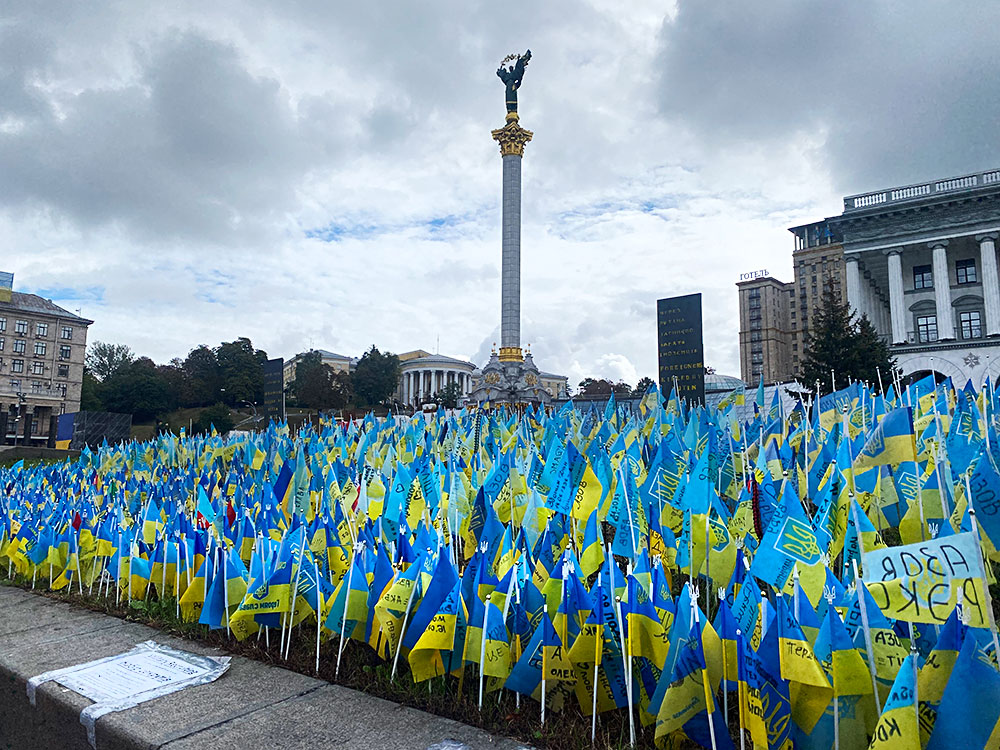
The all-clear siren sounds around 7 a.m., and I hear doors opening and chairs scraping as Kryva Lypa’s waiters and baristas start another business day during wartime. That's when my thoughts turn to the Maidan.
“If the Russians go nuclear,” it suddenly hits me, “The Maidan will surely be ground zero! If the Russians are already attacking libraries, memorials and other cultural institutions, they will obviously want to destroy the central symbol of Ukraine's independence movement.”
I feel like crying, but the tears don't come.
As horrific, unimaginable and destructive as nuking the Maidan will be for Russia, Europe and the world, as well as of course for Kyiv and the people of Ukraine, those are the Kremlin's stakes, which it has been raising since a few days after the war started. Given Russia's systemic corruption, poor weapons, untrained soldiers and tradition of extreme violence, there will eventually be nowhere else for them to go for a path to victory. Nuking the Maidan will be counterproductive, politically, strategically and militarily, most analysts agree, but more militant and angry Russians, like members of the white supremacist mercenaries, the Wagner Group, now central to Russia’s war effort, get a perverse pleasure from being world-class killers.
"Never Again" seemed like a reasonable goal when I was coming up, but history suggests there will always be more genocides, that all weapons eventually get used, and some sort of nuclear attack is just a matter of time. Contemplating those conclusions can be psychologically devastating but we have to embrace the possibilities.
Nevertheless, the horror can't go on forever, history also indicates. Someday it will end, and Ukrainians will rebuild, restore and heal, as they did after the Holodomor, the Great Terror and the Nazis. Indeed, the kids of Maidan grew up hearing how their grandparents did exactly that, they just enjoyed three decades of democracy, which they refuse to renounce, and they love each other dearly.
It may take a decade or two to vanquish the Russian Federation, to give them enough death to inspire treaty adherence, to scrub Kyiv of radioactivity and reconstruct the Maidan in all its glory—to put Berehynia back on her golden pedestal—but Ukraine will survive, of that I suddenly feel certain, having gotten to know the kids of Maidan.
I lull myself to sleep in my tiny bed, which finally warmed up, imagining how the Maidan will look during its first Victory Day celebration, which I am determined to attend. I see happy faces, despite the horrific death toll and suffering, because surmounting that soul-crushing sorrow is an obligation of Ukraine's geographical-historical destiny. I hope my decades of Holocaust and mystical studies are enough to offset my own sadness and help them with theirs, especially when I see some of my Ukrainian friends and, if the road to peace is long and they survive, their kids. I also hope to meet an incredible crew of freedom fighters and lovers from around the world, including, I hope, anti-fascist Russians.
Drifting into dreamland, I fantasize about the speakers and performers on the Maidan’s proscenium for Victory Day. There will be some fantastic dancers, I assume, as well as performances and art shows around the square and across Kyiv and Ukraine. There will surely be seminars and conferences addressing how to restore a devastated economy, infrastructure and environment, augment psychological services or develop dialogues in polarized societies, which Americans would do well to attend. I also hope there will be presentations on the Roma crisis, LGBTQ rights and Jewish history tailored to Ukrainians.
I left Ukraine on October 9th, the sky still dark with impending storms. Eighteen hours later, the air raids in Lviv and Kyiv were real, as Russia began its strategic bombing campaign against power and water facilities. In Lviv, the missiles did not kill anyone directly but the electrical blackouts did. None of my friends were seriously affected—they claimed it was nothing new, or they posted photos of candle-lit dinners—but I felt I had deserted them.
Things will get bad as temperatures drop, surgeons operate by flashlight, the elderly and young freeze, and World-War-One-style trench and artillery battles rage across the 500-mile eastern front. Meanwhile, the Kremlin keeps upping its ante: more infrastructure bombings, more relentless attacks, more soldiers mobilizing, more torturing of civilians, and more threats of their nihilist nightmare, nuclear holocaust.
Imagine what a populous, prosperous and peaceful country Russia would be today if they hadn’t killed so many of their own people as well as others. Despite their world-class literature, their leaders appear unfamiliar with a central fact of human history: If bullies were so successful down through the ages, we'd still be living in caves.
It will be tragic, it will be brutal, it will be genocide, even without the detonation of nuclear devices. Unfortunately, the efficacy of our ideas—and how they trickle down to civic society, culture, technology and discipline—are periodically tested by those who fantasize that extreme amorality and brutality can bring victory. Sadly, the only way to prove them wrong is by force of arms. During this difficult moment of historical transition to a digital, diverse and civil-rights-supportive world, the kids of Maidan may end up saving not only Ukraine but the spirit of democracy.



